The Evolution of the Orgasm
Psychology broadly, as well as evolutionary psychology specifically, is concerned with both the ultimate and proximate causes of human behavior. Proximate causes may be understood as immediate or adjacent causes of a behavior, while ultimate causes are explanations for why the behavior evolved or exists (Scott-Phillips et al., 2011). For example, a proximate cause for eating food is the feeling of hunger. Meanwhile, the ultimate cause of feeling hunger is that it facilitates survival (you must eat to live).
Sexual behavior, too, can be understood in the context of both proximate and ultimate causes. A recent video entitled, “I Debunked Evolutionary Psychology” chided psychologists for researching the evolution of the female orgasm and proposed a simple explanation: the female orgasm exists for pleasure. (If you are interested in YouTube videos you can watch evolutionary psychologist William Costello and Alexander respond here).
This is akin to saying we evolved an enjoyment of sweet food because it tastes sweet. It is circular and it does not attempt to explain why we evolved preferences for sweet food at all (why didn’t we evolve a similarly strong preference for rancid foods or for lawn clippings). Ultimate or evolutionary explanations for universal sweet-food preferences in human beings point toward its role in survival: sweet foods are dense in calories and facilitated survival in calorie-scarce environments (Breslin, 2013).
Orgasms in mammals need similar evolutionary explanations, too. Not all animals experience orgasm and many animals reproduce without the kind of sexual intercourse we observe in human beings. The pleasure that human beings experience during sex, which many animals seem not to experience, may be a primary reinforcer that motivates human beings to copulate (Fleischman, 2016). Further, the adaptive function of human sexual pleasure and the orgasm may extend beyond simply motivating copulation and into facilitating conception or the selection of mates.
As the male orgasm is almost always concurrent with ejaculation the adaptive function of the male orgasm is more clear. However, women often do not orgasm during sex — nor is the female orgasm essential for conception. It is important to be clear that this does not mean that the female orgasm serves no function. The female orgasm may facilitate conception, per some hypotheses, increasing conception likelihood. Further, the female orgasm may discriminate. Not conceiving, in many contexts, may also be adaptive (Gangestad et al., 2023). Selecting the right mate is adaptive, too, and the female orgasm may play a role in facilitating a correct selection.
In other words, high variability in the female orgasm may have evolved for a reason. As much as women want to experience orgasms in their own sexual relationships, and as much as men (hopefully) want to give orgasms to their romantic partners, the relative difficulty compared to men that women have in achieving orgasm may have an ultimate purpose.
Evolutionary Hypotheses for the Female Orgasm
An early byproduct hypothesis for the female orgasm was that it is vestigial, akin to nipples in men (Symons, 1979). In other words, the female orgasm currently serves no adaptive function. Perhaps the female orgasm did serve a function at some point in the past or is a relic of anatomical differentiation. It may represent a mere “bonus” to sexual pleasure derived from similar embryonic development (Zuk, 2006). This is currently a less popular hypothesis, as there is substantial evidence for function associated with the female orgasm, but it is worth pointing out that this has been proposed in the past and has been argued beyond the early proposals of Symons (e.g. Wiederman, 2007).
Biomechanical hypotheses for an adaptive function of the female orgasm have also been proposed. The popular upsuck hypothesis notes that uterine contractions during orgasm may facilitate the transportation of semen and increase conception probability (Baker & Bellis, 1993; Palode & Evans, 2022). This has had considerable support in animal models, although it has been challenged in human research on empirical and theoretical grounds (Wiederman, 2007).
Hypothesis of Mate Selection: Sire Selection & Pair Bonding
More promising hypotheses for the adaptive function of the female orgasm involve its potential role in mate selection (Miller, 2001; Puts, 2012). Pair-bonding hypotheses of the female orgasm propose that it has an adaptive function to facilitate the formation of long-term pair bonds, as well as to select potential mates who are willing to commit and invest.
Sire choice hypotheses propose that the female orgasm facilitates the selection for and conception by a “good genes” sire, or a mate with high phenotypic quality. Substantial support for sire choice hypotheses are found in higher orgasm frequency with men who are more physically attractive and who have desirable physical traits (for a review of the literature, see Puts, 2012).
It is important to note that hypotheses proposing adaptive biomechanical functions (“upsuck”) of the female orgasm, sire choice, or pair-bond formation are not mutually exclusive. The female orgasm may fulfill all of these functions. They are only inconsistent with hypotheses that propose no function (“byproduct hypotheses”).
The Orgasm Gap
The orgasm gap describes the highly replicated finding that men experience orgasms in sexual encounters more than women do (for a review of the literature, see Mahar et al., 2020). Men usually experience an orgasm during sexual encounters, but women often do not. This gap is even larger when examining short-term versus long-term relationships: in casual sex relative to long-term relationships, women experience orgasms even less frequently (Piemonte et al., 2019). Orgasm frequency is also predicted by the duration of casual sexual encounters, such that women experience orgasms more frequently not only in long-term relationships relative to short-term relationships, but also in short-term relationships of longer duration (Armstrong et al., 2012).
Women also experience a similar, but smaller, gap in subjective sexual satisfaction and higher sexual regret (for a review and meta-analysis, see Peterson & Hyde, 2010). In short-term relationships, women also experience less regret when sexual satisfaction is higher (Kennair et al., 2018). Positive and negative feelings about past sexual experiences, such as reports of sexual satisfaction, are also predicted for women by having experienced an orgasm — and some research has found that when orgasm is accounted for the sex difference in satisfaction disappears (Piemonte et al., 2019).
The orgasm gap has a straightforward proximal explanation: some men really don’t try to give their partners orgasms. Vaginal intercourse is substantially less likely to produce an orgasm in comparison to manual or oral stimulation (Blair et al., 2017; Herbinck et al., 2018). Many men do not perform oral sex on their partners, especially in casual or short-term contexts. In one study, 25% of men could not even locate the clitoris on a diagram of a female vulva (Wade et al., 2005).
Various reasons may exist for why men are not motivated to ensure female partner orgasms nor perform oral sex. Among those may be antisocial personality traits, such as selfishness (Lewis & Marston, 2016). This begins to point toward ultimate causes. If the female orgasm is associated with sexual satisfaction, relationship satisfaction, and relationship longevity (as we will see in the following sections), and prosocial men are more likely to produce orgasms for female partners, then we may expect a selection for prosocial traits. Indeed, the female orgasm has been proposed as one explanation for the evolution of highly prosocial behavior in human beings (Kennedy & Pavličev, 2018).
Pair Bond or Long-Term Mate Selection Hypotheses
The formation of dyadic pair-bonds is ubiquitous across human cultures and monogamy represents the dominant human mating pattern (Schacht & Kramer, 2019). Given robust associations between sexual satisfaction and relationship satisfaction (Fallis et al., 2016; Sprecher et al., 2004; Yeh et al., 2006), as well as strong associations between orgasm and sexual satisfaction (Frederick et al., 2016), we may expect orgasm to have a role in partner selection and pair-bond maintenance.
Both orgasm frequency and sexual satisfaction are higher for women in committed sexual relationships over casual sexual relationships (Birnie-Porter & Hunt, 2015; Armstrong et al., 2012). In a large sample of sexually active women, even women who had both casual and committed sexual partners over the past year had higher orgasm frequency with their committed partners (Wogsomboon et al., 2020).
High sexual satisfaction is protective against relationship dissolution (French et al., 2019) and is associated with higher experiences of love, commitment, and relationship stability (Sprecher, 2002; Sprecher et al., 2004). Sexual autonomy and sexual communication have also been associated with longer relationship duration in adolescent and young adult relationships (Hensel & O’Sullivan, 2022). Orgasm frequency is associated with perceptions of relationship quality and sexual closeness, which in turn predict better long-term relationship outcomes (Frost et al., 2017).
Human beings have a wide repertoire of mate-retention strategies. These strategies have been described as those that either provide benefits or impart costs to romantic partners. In other words, you can induce a romantic or sexual partner to stay with you by engaging in behavior that makes them want to stay, or by engaging in behavior that makes it difficult for them to leave.
Mate retention strategies that provide benefits have been found to be associated with higher relationship satisfaction, while cost-inflicting mate-retention strategies are associated with lower relationship satisfaction (Salkicevic et al., 2014; Vance et al., 2023). Further, individuals of higher mate value are more likely to use benefit-provisioning, rather than cost-inflicting, mate retention strategies (Salkicevic et al., 2014). One mediator of benefit-provisioning mate-retention strategies and relationship satisfaction is sexual communion — the extent to which a male partner cares about, and is invested in, the sexual satisfaction of his female partner (Vance et al., 2023).
Given that orgasm frequency and sexual satisfaction are closely linked — and that male care for producing orgasms in female partners is itself a mate-retention strategy — we may also expect that orgasm has a current role in facilitating the maintenance of pair-bonds. At the very least, orgasm is a proximal cause of relationship maintenance and quality. Women are happier in relationships where they experience orgasms more frequently. Relationships with higher orgasm frequency also last longer. This is consistent with orgasm being an adaptive solution to pair-bond formation and mate retention, although not proof of it as an ultimate cause. Given that human beings form long-term pair bonds, but also frequently end relationships as well as engage in infidelity, we may also propose that such behavioral adaptations evolved to facilitate the retention of mates (Buss & Shackelford, 1997).
Animal research also points toward the role of the female orgasm in pair-bond formation and social bonding. Prairie voles, an exclusively monogamous species of rodent, have been used as a model for demonstrating the role of oxytocin and vasopressin in pair bonding (Insel & Hulihan, 1995; Young & Wang, 2004). During orgasms, similar oxytocin spikes occur for human beings (Cera et al., 2021). When viewing videos of romantic partners, women who reported higher levels of love, gratitude, and reward also had higher levels of circulating oxytocin (Algoe et al., 2017). In Japanese macaques, orgasm frequency was highest for low-status females paired with high-status males, and lowest for high-status females paired with low-status males (Troisi & Carosi, 1998). Bottlenose dolphins form social bonds through sex (Brennan et al., 2022) and oxytocin produced during sexual encounters has been associated with the formation of coalitions in bonobos (Moscovice et al., 2019). These lines of animal research provide a biological explanation for how sex and the orgasm facilitates the formation of long-term pair-bonds.
Orgasm and the Selection For Prosocial Traits in Short-Term Mating
A great deal of research has been done on the selection of prosocial traits in long-term mating. In general, findings tend to show that prosocial traits and behaviors are more desirable in long-term mating contexts than in short-term mating contexts (Barclay, 2010; Bhogal et al., 2010). These findings are robust and consistent with Sexual Strategies Theory (Buss, 2023). We should expect traits that are more adaptive for long-term mating to be subjectively perceived by individuals as more important in long-term mating.
However, a common misconception is propagated when results like these are shared with little detail in the news and on social media: that prosocial traits are unimportant — or even worse, undesirable — in short-term mating. This is generally not what results show. The statement that a trait may be more desirable in a long-term context is not synonymous with a finding that the trait is undesirable or unimportant in a short-term context. Rather, high prosocial traits tend to be valued in both short and long-term relationship contexts (Stewart et al., 2000; Regan et al., 2000; Ehlebracht, 2013; Farrelly & King, 2019).
Much popular discourse also takes place around which traits are most important in short-term mating contexts. For men and women, physical attractiveness tends to top the list. However, when attractiveness criteria are fulfilled men and women begin to allocate more importance to nonphysical, and specifically prosocial, traits beyond that point (Li & Kenrick, 2006). This also produces an interaction effect where the most desirable short-term mates are both physically attractive and prosocial (Farrelly & King, 2019). When women perceive potential casual sex partners as having higher parental investment and a greater willingness to commit for a long-term relationship, they are more willing to have sex with them (Surbey & Conohan, 2000).
Past research has found associations between prosocial behavior, sexual frequency, and orgasm frequency. Women initiate sex more with men who they perceive as higher in motivation, intelligence, focus, and determination — and also have greater orgasm frequency with men who had a better sense of humor and higher sexual satisfaction with men who they felt protected by (Gallup et al., 2014). Humor, creativity, warmth, and faithfulness in a male partner are also associated with higher orgasm frequency for women (Sherlock et al., 2016).
Further, past research has also found differences in orgasm quality related to male partner traits. Female orgasm intensity and frequency are positively associated with perceptions of their male partner’s investment (Ellsworth & Bailey, 2013). In one study, only orgasm with a familiar partner predicted subjective sexual satisfaction for women (Lentz et al., 2021). In another study using vignettes, female orgasm frequency was associated with perceptions of partner care, expected relationship duration, and relationship satisfaction (Nebl & Gordon, 2022). In support of the long-term pair bonding hypothesis, associations between orgasm frequency, relationship duration, and relationship satisfaction were fully mediated by perceptions of partner care and participant love for her partner.
Sexual frequency is particularly important to note, given that there is a low probability of conception for a single sexual encounter. In a large majority of cases, the selection for “good genes” is concurrent with selection of a long-term mate. In other words, most women are having children with men they are in long-term relationships with. Not only is this true for modern environments, but population-wide genetic evidence indicates that this has been the case for at least a few hundred years (Larmuseau et al., 2013; Greeff & Erasmus, 2015; Larmuseau et al., 2016). The evolution of concealed estrus in human beings and the fact that human beings copulate across both fertile and nonfertile periods of the menstrual cycle further reduces the probability of conception from single or infrequent copulations (Gangestad et al., 2022).
This raises questions as to the ultimate or evolved purpose of short-term or casual sexual encounters. It is not required that we settle upon a single purpose; short-term mating could serve multiple functions and may also have served different functions during different periods of human ancestral history. However, it is unlikely that the adaptive function of the female orgasm is entirely explained by a selection for good physical traits, particularly in light of selection for traits in short-term mating that are also beneficial in long-term pair-bonding.
One hypothesis for the evolution of concealed estrus in women is that it allows for a further selection of long-term partners, in addition to “good genes,” through short-term mating. Concealed estrus provides human females with an extended sexuality absent in many other animals that provides adaptive benefits beyond conception. This extended sexuality may allow women to assess potential mates beyond initial selection without the risk of pregnancy (Gangestad et al., 2023). If this is the case then we should expect traits valuable in long-term pair-bond formation to also be valuable in less committed short-term sexual relationships. We should also expect short-term relationships of longer duration to be associated with traits considered valuable in long-term relationships.
It is important to remember that when considering the ultimate or evolved contributions to human mating preferences this does not mean that individuals always have conscious awareness of their choices (Buss, 2023). In other words, few people may explicitly consider their own short-term mating intentions as long-term mate seeking. Nonetheless, they may still select short-term mates who have traits that are adaptive for long-term pair-bonding. Some past research has found that most people in short-term sexual relationships do consciously desire a long-term relationship with their partner (Garcia & Reiber, 2008) and that if the potential for a long-term relationship exists women are more likely to have casual sex (Surbey & Conohan, 2000). Results of this nature provide additional evidence for the hypothesis that short-term mating has a role in facilitating long-term mating, but they are not a necessary expectation.
Expectations and Findings
We performed an exploratory study on short-term mating selection and the female orgasm with evolutionary perspectives in mind. Given past research and the theoretical underpinnings described above we can look at what results might be consistent with sire selection and pair-bonding hypothesis.
For a fast summary of results, we recommend scrolling down to the Result Summary section.
Methods
We recruited a convenience / snowball sample from social media. Demographic participant data was collected on age, sex, sexual orientation, educational level, political identification, feminist identification, polyamorous identification, height, and self-rated physical attractiveness. Participants were screened for those who had a short-term sexual relationship and questions on short-term partner traits pertained to their most recent short-term sexual partner.
Participants assessed their most recent short-term sexual partner for height, education, socioeconomic status, political ideology, feminist belief, described their relationship with their short-term sexual partner from a selection of terms, and reported how many times they had sex with their short-term sexual partner.
Participants also rated agreement with a selection of motivations to have sex with a short-term sexual partner, as well as a selection of statements indicating their own emotional feelings and intentions with a short-term sexual partner. Participants rated their most recent short-term partner on antisocial and prosocial traits, as well as intelligence.
Participants also indicated if they experienced an orgasm during the first sexual encounter with their last short-term partner and if they experienced an orgasm at any time with their last short-term sexual partner.
Data, full survey items, and R code is available here.
Results
Sample Characteristics
284 participants responded to our survey via social media of which 222 reported that they had a short-term sexual relationship. One additional participant was excluded from the analysis due to indicating that they had zero sexual encounters with their short-term partner. We defined a short-term sexual relationship expansively for participants as “anyone that you have had sex with outside of a committed relationship” in order to capture a broad range of experiences.
The mean age of women in the final sample was 38.07 years (SD = 10.29). For men, the mean age was 35.41 years (SD = 9.55). Political ideology and feminist self-identification were measured on a 7-point linear response scale. The mean political orientation score for women was 3.63 (SD = 1.47). For men, the mean political orientation score was 4.28 (SD = 1.64). The mean feminist identification score for women was 4.77 (SD = 1.75). For men, the mean feminist identification score was 3.40 (SD = 1.83). Education level was split into three response categories: “High School or Below,” “Some College or Bachelor’s Degree,” and “Master’s Degree or Above.” The education distribution for women was 8.57% with a high school education or below, 48.6% with some college or a Bachelor’s degree, and 48.% with a Master’s degree or above. For men, 4.64% had a high school education or below, 55.6% had some college or a Bachelor’s degree, and 39.7% had a Master’s degree or above.
Image 1 shows distributions of sample characteristics. In short, the sample had a wide range of ages, had high levels of education relative to the US population, and was ideologically split on feminist and political identification in a way similar to the general US population.

Participants also reported their own sexual orientation and the sex of their most recent short-term sexual partner. For women, 20.00% identified as bisexual, 1.43% identified as gay/lesbian, and 78.57% identified as heterosexual. For men, 5.96% identified as bisexual, 1.32% identified as gay/lesbian, and 92.72% identified as heterosexual. Short-term sexual pairings were predominantly heterosexual in nature: 95.48% of all short-term partners were of the opposite sex, while only 4.52% were of the same sex. Due to the small number of same-sex pairings (only 3 women reported that their last short-term sexual partner was another woman) these participants were included for the final analysis.
Participants also self-rated their own physical attractiveness. Past research has found that self-ratings of physical attractiveness are correlated with third-party observer (objective) ratings (Webster et al., 2024), but also that individuals of lower physical attractiveness overestimate their own physical attractiveness (Greitemeyer, 2020). We did not find a sex difference in self-reports of physical attractiveness; the mean for women was 5.09 and for men was 4.88 (t(165.2) = 1.41, p = .162, 95% CI[-0.08, 0.49], d = 0.19).
Image 2 shows self-ratings of physical attractiveness split by sex.

Participants reported their own heights. Table 1 below shows self-reported height ranges. Women in our sample were slightly taller than what might be expected from the US population average and men were substantially taller. Past research has found that men overreport their own heights (Craig & Adams, 2009; Lee et al., 2011), but given associations between height and attractiveness we may also expect a taller male sample on average.
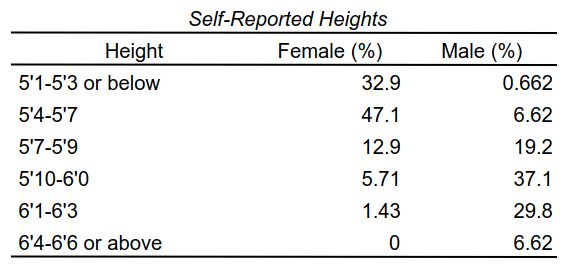
Short-Term Sexual Relationship Features
We asked participants to indicate where they met their last short-term sexual partner. Image 3 shows percentages for the full sample. Splitting this into in-person versus online meetings, approximately 50.23% met short-term partners in-person and 49.77% met short-term partners online.

We also asked participants to classify their short-term sexual relationships. Participants were able to select one or more terms to define them: hook-ups, one-night stands, situationships, casual dating, friends with benefits, and “other.” As participants were able to select more than one term to describe their last short-term relationship, we visualized this with an upset plot to show intersections between terms (Image 4).
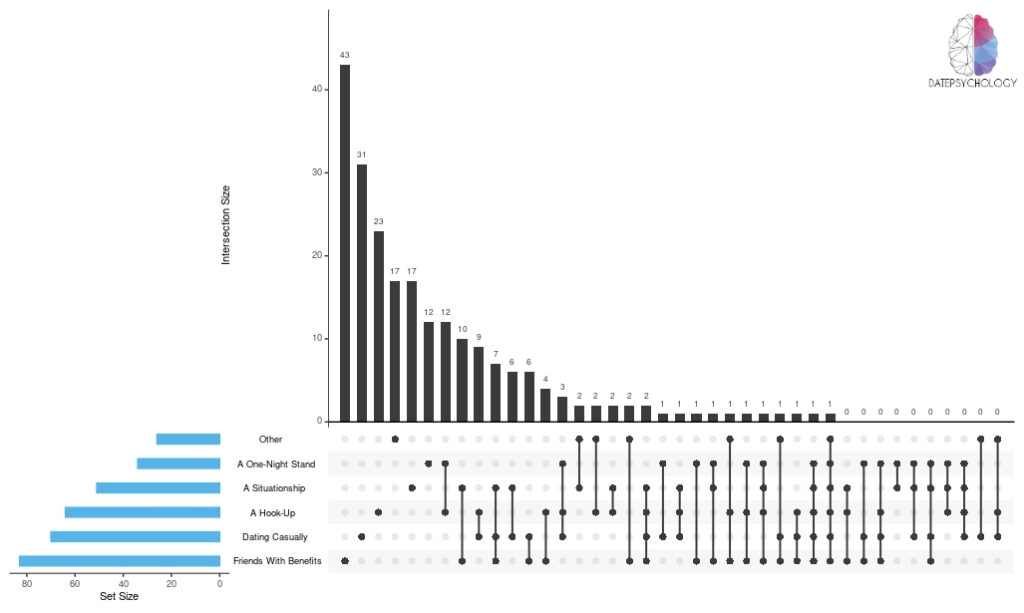
“Friends with benefits” and “dating casually” were the most frequent responses. Hook-ups and one-night stands were less common. This is consistent with recent research indicating that many short-term relationships may be better described as “intermediate” relationship styles (Eastwick et al., 2019). Short-term relationships are not committed nor necessarily exclusive sexual relationships, but neither are they only random sexual encounters or “one-offs” with strangers.
This can also be seen in participant responses to our question, “How well did you know your short-term sexual partner” (Image 5). We found no significant difference between men and women on this question (t(124.33) = 1.38, p = .169, d = 0.21, 95% CI [-0.17, 0.95]).
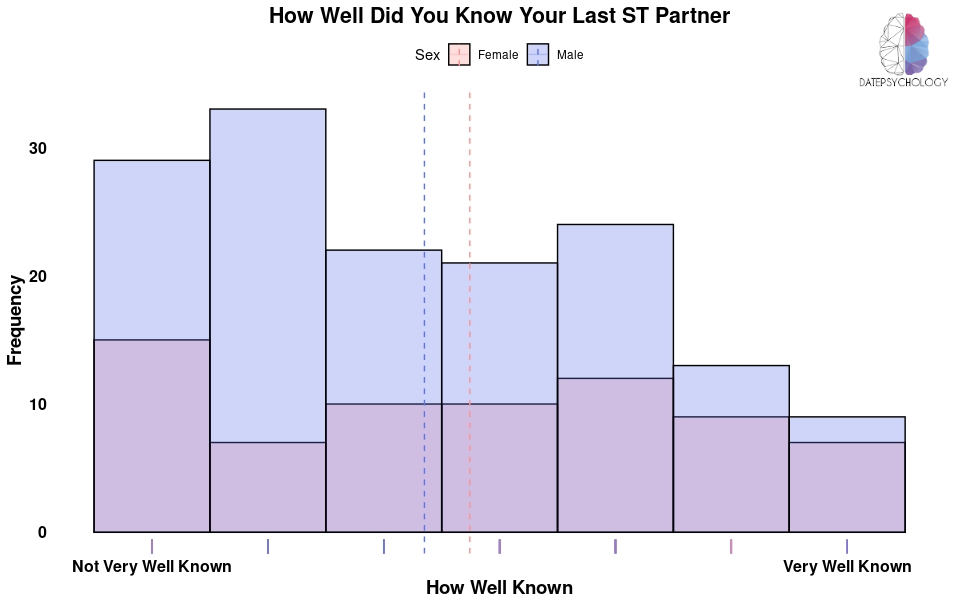
We also asked participants a few binary (YES/NO) questions in regards to their knowledge of their last short-term sexual partners. Table 2 shows YES responses, or the percentage of men and women who responded that they did know what their partner’s age, education, socioeconomic status, politics, and degree of feminist belief was. Sex differences in partner knowledge were not significant for any of these items (all ps > .05).

Emotional Connections and Relationship Intentions
We asked participants to indicate their agreement with four statements on a 7-point linear response scale from “Strongly Disagree” to “Strongly Agree:” “I was in love with my short-term sexual partner,” “I had an emotional attachment to my short-term sexual partner,” “I was interested in having a committed relationship with my short-term sexual partner,” and, “I met my short-term partner while I was seeking a long-term relationship.” Image 6 shows the results for these:
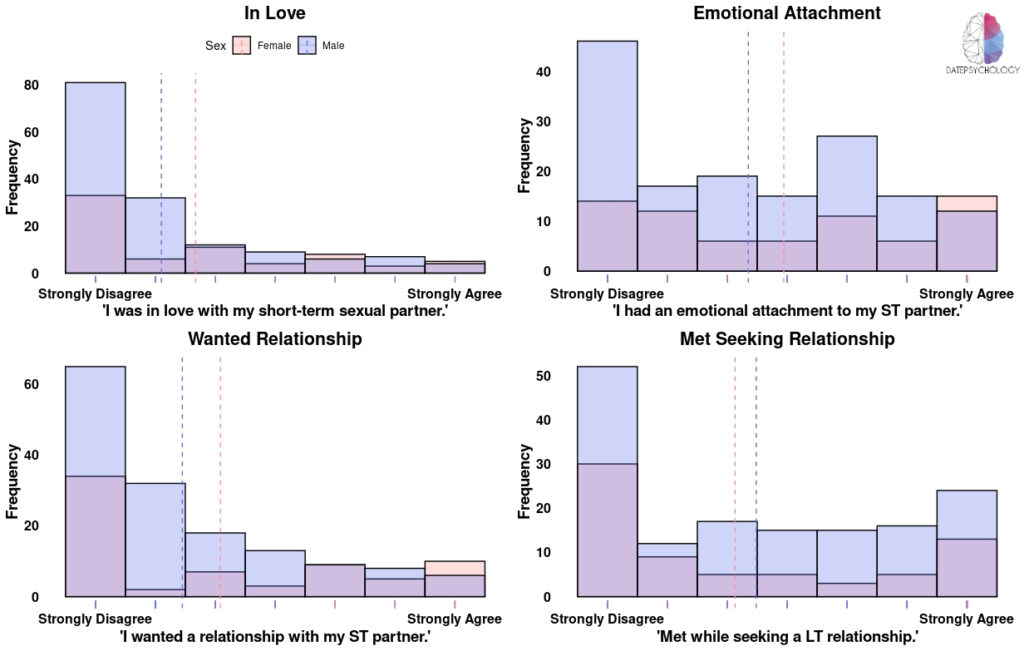
Women were more likely than men to be in love with short-term sexual partners (t(112.95) = 2.10, p =0.038, d = 0.33) and to desire a relationship with short-term sexual partners (t(106.1) = 2.01, p = 0.046, d = 0.32). Sex differences were not significant for emotional attachment (t(123.99) = 1.87, p = 0.064, d = 0.28) nor having met while seeking a committed relationship (t(128.99) = −1.04, p = 0.302, d = −0.15).
Table 3 shows response percentages categorized in order to show sex differences at different points in the distribution. Women were twice as likely as men to be in love with their short-term sexual partners and twice as likely as men to want a committed relationship with their short-term sexual partners. Women were also more likely than men to be emotionally attached to short-term sexual partners and women were as likely to agree with the statement that they were emotionally attached as not.

We also asked participants to indicate the extent to which they believed their short-term partners felt with a similar series of items: “my short-term sexual partner was in love with me,” “my short-term sexual partner had an emotional attachment to me,” and “my short-term sexual partner was interested in having a committed relationship with me.” Image 7 shows participant responses to these questions split by sex:
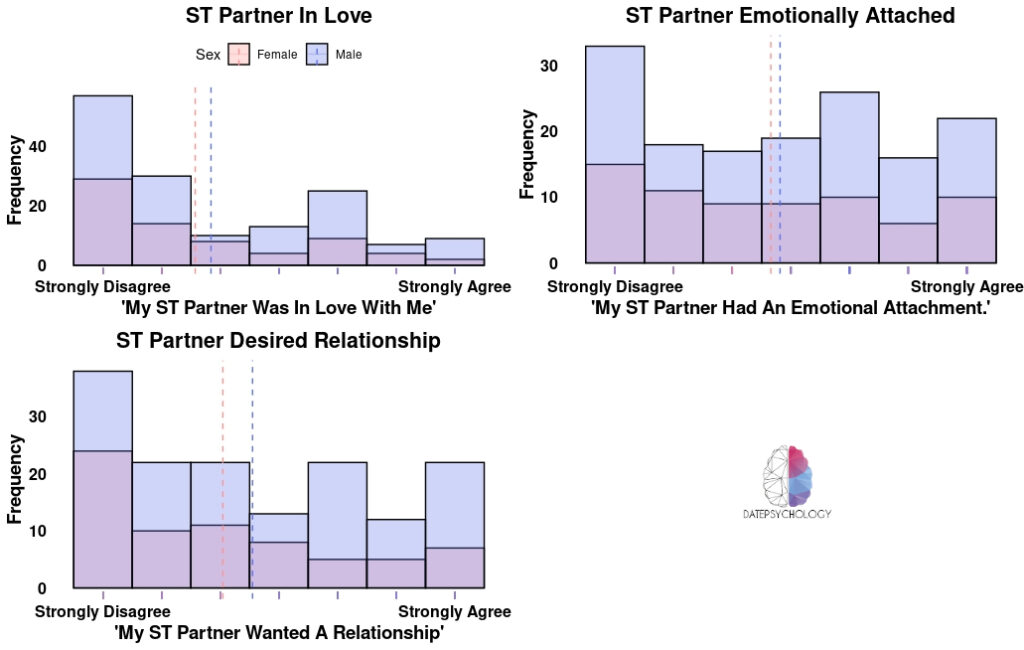
We found no significant sex differences on these three items: the belief that a ST partner was in love (t(144.76) = −1.01, p = 0.32, (95% CI [-0.43, 0.14]), d = −0.14), the belief that a ST partner had an emotional attachment (t(135.28) = −0.52, p = 0.61, 95% CI[−0.36,0.21], d = −0.07), and the belief that a ST partner wanted a committed relationship (t(139.93) = −1.68, p = 0.10, 95% CI[−0.53,0.05], d = −0.24). Table 4 shows the percentages of these responses categorized:

Male reports in Table 4 roughly mirror female reports in Table 3 for being in love: men were twice as likely to say that their ST partner was in love with them as they were to say that they were in love with their short-term sexual partner.
Participants also reported that their ST partners were in love with them more than they were in love with ST Partners (t(437.14) = -2.72, p = 0.007, 95% CI[-0.82, -0.13], d = -0.26) and that their ST partners desired a relationship with them more than they desired a relationship with ST partners (t(437.91) = -3.77, p < 0.001, 95% CI[-1.12, -0.35], d = -0.36). However, we did not find a significant difference between reports of having an emotional attachment to ST partners and reports of ST partners having an emotional attachment to participants (t(439.93) = -1.12, p = 0.26, 95% CI[-0.62, 0.17], d = -0.11).
We also found significant correlations between participants’ own emotional reports and how they perceived their short-term sexual partners’ emotions and relationship intentions. A positive correlation was observed between reports of being in love and reports that a ST partner was in love (r(219) = 0.47, p <0.001, 95% CI[0.36,0.57]), having an emotional attachment with a ST partner and perceptions that the partner had an emotional attachment (r(219) = 0.53, p < 0.001, 95% CI[0.43,0.62]), and the desire for a committed relationship with the perception of ST partners’ having a desire for a committed relationship (r(219) = 0.14, p =0.037, 95% CI[0.01,0.27]).
Motivations for Short-Term Sexual Relationships
We asked participants what their motivations were for short-term sexual relationships: seeking a relationship, being physically attracted, feeling lonely, feeling horny, and wanting to feel validated. Image 8 shows participant responses split by sex:
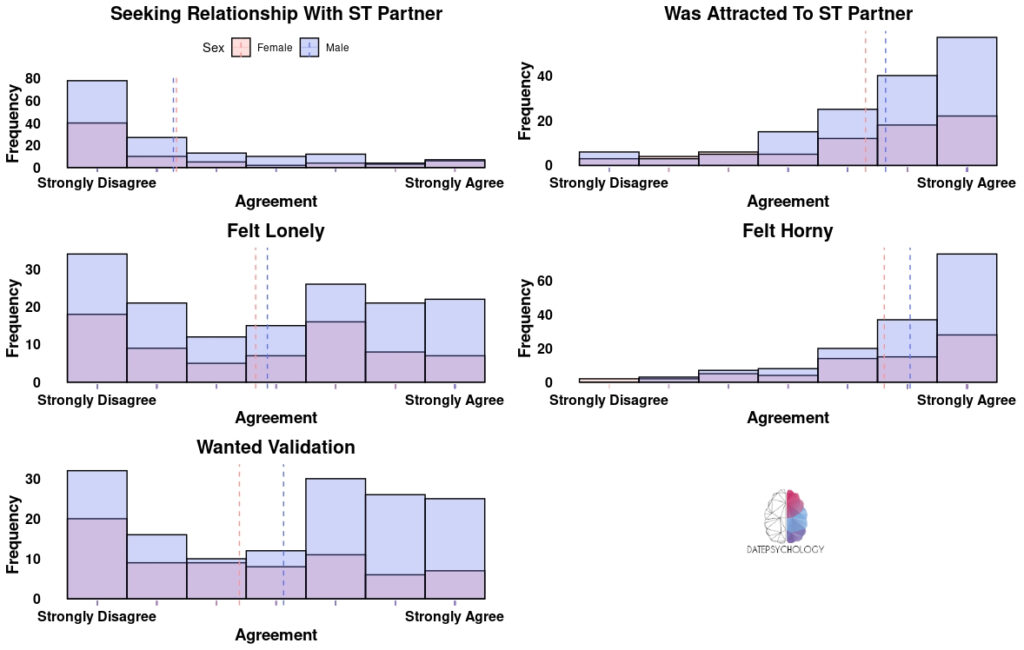
We found no significant sex differences for the motives of seeking a committed relationship with a ST sexual partner (t(119.86) = 0.18, p = 0.86, 95% CI[-0.50, 0.60], d = 0.03), being physically attracted to a ST sexual partner (t(121.26) = -1.37, p = 0.17, 95% CI[-0.82, 0.15], d = -0.21), or feeling lonely (t(138.33) = -0.64, p = 0.52, 95% CI[-0.81, 0.41], d = -0.64).
Significant differences were observed for the motivation of feeling horny (t(110.76) = -2.00, p = 0.048, 95% CI[-0.86, -0.004], d = -0.31) and for desiring validation (t(141.36) = -2.43, p = 0.017, 95% CI[-1.34, -0.14], d = -0.34), with men scoring higher on both of these items.
Prosocial and Antisocial Traits of Short-Term Sexual Partners
Participants responded to eleven items describing short-term sexual partners on a 7-point linear response scale. Five of these items described antisocial traits associated with the Dark Triad (impulsive, manipulative, deceitful, selfish, and rude) and five items described prosocial traits (empathetic, kind, respectful, altruistic, and trustworthy). One item asked participants to indicate how intelligent they believed their last short-term sexual partner was. Image 9 shows distributions split by sex for antisocial and prosocial assessments of short-term sexual partners.
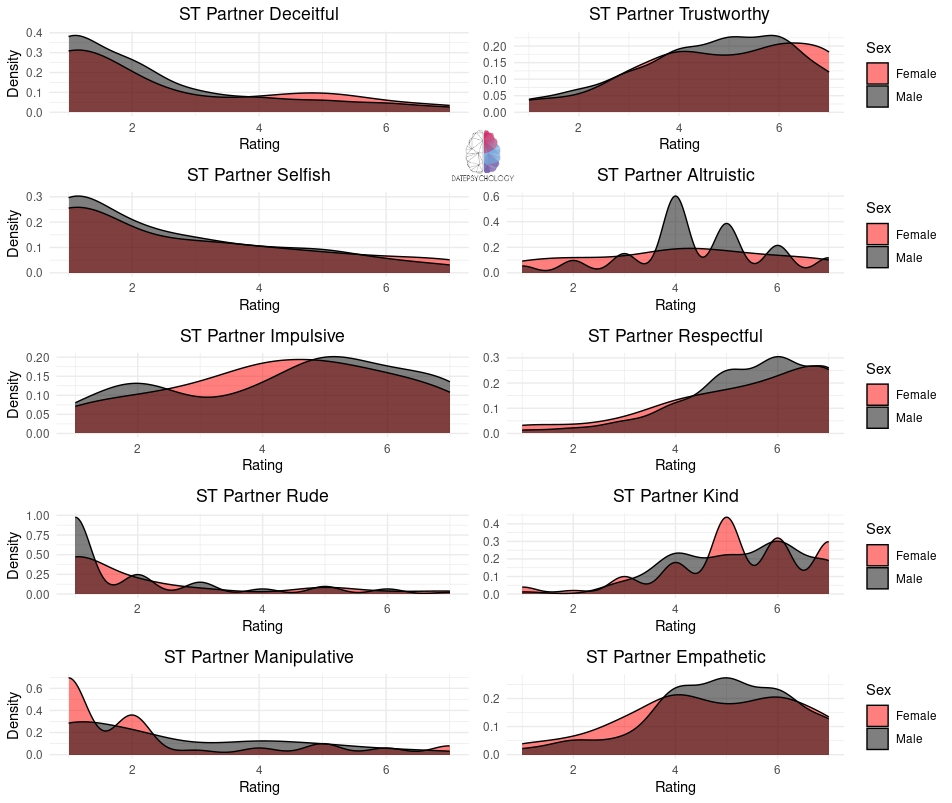
The general trend is that participants rated their short-term sexual partners high in prosocial traits and low in antisocial traits, with an exception for impulsiveness, which may be more ambiguous in meaning than the other traits assessed.
In fact, the difference between prosocial and antisocial total scores was significant and quite large in size (t(436.4) = 17.07, p < .001, 95% CI[1.41, 1.84], d = 1.62).
We also found no significant sex differences for total prosocial (t(116.97) = −0.49, p = .625, 95% CI[-2.37, 1.43], d = -0.06) or antisocial scores (t(125.3) = −0.02, p = .983, 95% CI[-2.04, 2.00], d = -0.003).
Image 10 shows participant assessments of their short-term sexual partner’s intelligence. In general, men and women both tended to judge short-term sexual partners high in this trait. Women rated short-term partners as slightly higher in intelligence than men rated short-term partners (t(134.68) = 2.20, p =.029, 95% CI[0.05, 0.87], d = 0.32).
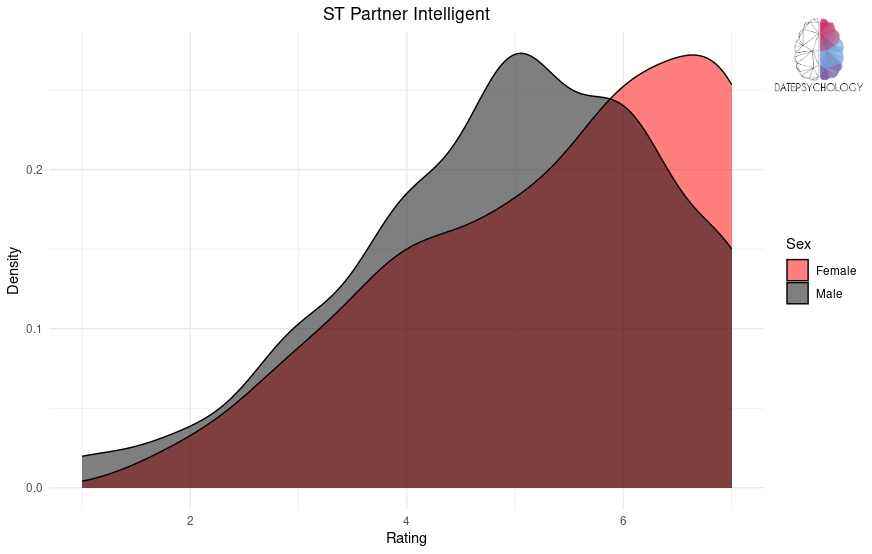
The Halo Effect and Ratings of Personality Traits
We found little evidence for a halo effect — the observation that more attractive people were perceived as having better personality traits — in our data.
Ratings of partner prosocial traits were not correlated with physical attractiveness (r(219) = 0.05, p = 0.498, 95% CI[−0.09,0.18]) nor were ratings of partner antisocial traits correlated with physical attractiveness (r(219) = 0.01, p = 0.864, 95% CI[−0.12,0.14]). For ratings of intelligence, we found a small correlation with ratings of partner physical attractiveness (r(219) = 0.16, p = 0.015, 95% CI[0.03,0.29]).
Frequency of Sex with Short-Term Sexual Partners
We asked participants how many times they had sex with their most recent short-term sexual partner. Image 11 shows these results. Multiple sexual encounters tend to be more common than “one-offs,” again indicative of how many short-term sexual relationships may be better understood as “intermediate” rather than the common perception of “short-term mating” as synonymous with single-event casual sex.
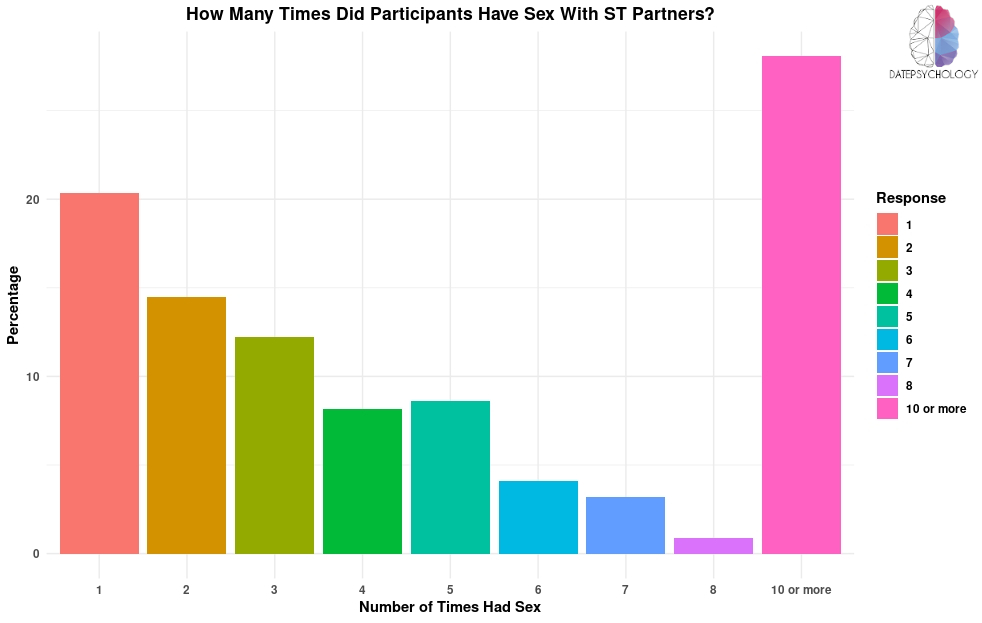
Replicating the Orgasm Gap
The orgasm gap is the highly replicated finding that men experience orgasms in sexual encounters more than women do (for a review of the literature, see Mahar et al., 2020). Men usually experience an orgasm during sexual encounters while women often do not. This gap is even larger when examining short-term versus long-term relationships: in casual sex relative to long-term relationships, women experience orgasms even less frequently than men do (Piemonte et al., 2019). Orgasm frequency is also predicted by the duration of casual sexual encounters (Armstrong et al., 2012). The chart below (Image 12) from Armstrong et al. (2012) shows how as short-term relationship duration increases so does the percentage of women who report having had an orgasm with their partner:
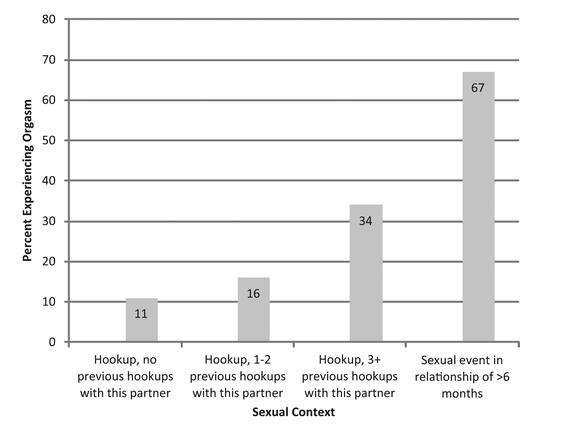
We replicate the orgasm gap in our current sample. We asked, “Thinking of the first time you had sex with your short-term sexual partner, did you have an orgasm?” 81.46% of men and 47.14% of women reported having an orgasm during the first sexual encounter (χ2(1, N= 221) = 25.50, p <.001). The orgasm gap also remained across the entire duration of sexual encounters. We asked, “Did you ever have an orgasm with your last short-term sexual partner?” 92.05% of men and 65.71% of women reported having ever had an orgasm with their last short-term partner (χ2(1, N= 221) = 22.44, p <.001).
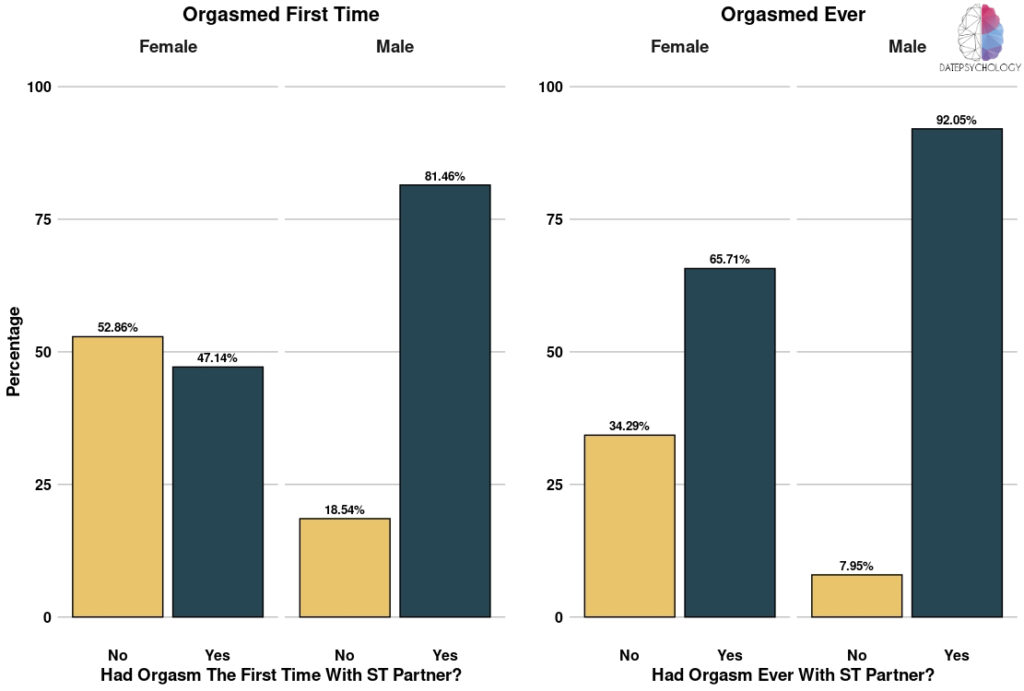
Female Orgasm at First Sexual Encounter Predicts Having Future Sexual Encounters
We also replicate the pattern of increasing orgasm frequency with short-term relationship duration in our current sample. Female participants who had more sexual encounters with their last short-term partner were more likely to report having ever had an orgasm (χ2(3, N = 221) = 8.12, p = .044) (Image 14).
Additionally, we found an effect of having experienced an orgasm during the first sexual encounter with short-term relationship duration. Female participants who reported having an orgasm with their short-term partner the first time they had sex were significantly more likely to go on to future sexual encounters compared to those who did not (OR 3.6, p = 0.0099, 95% CI[1.35, 10.10]). In other words, women who had an orgasm were approximately 3.6 times more likely to keep having sex.

Image 15 shows another visualization of these results. 66.67% of women who experienced an orgasm the first time with their last short-term sexual partner would go on to have sex with that same short-term sexual partner five times or more, in contrast to only 35.14% of women who did not experience an orgasm the first time with their short-term sexual partner.
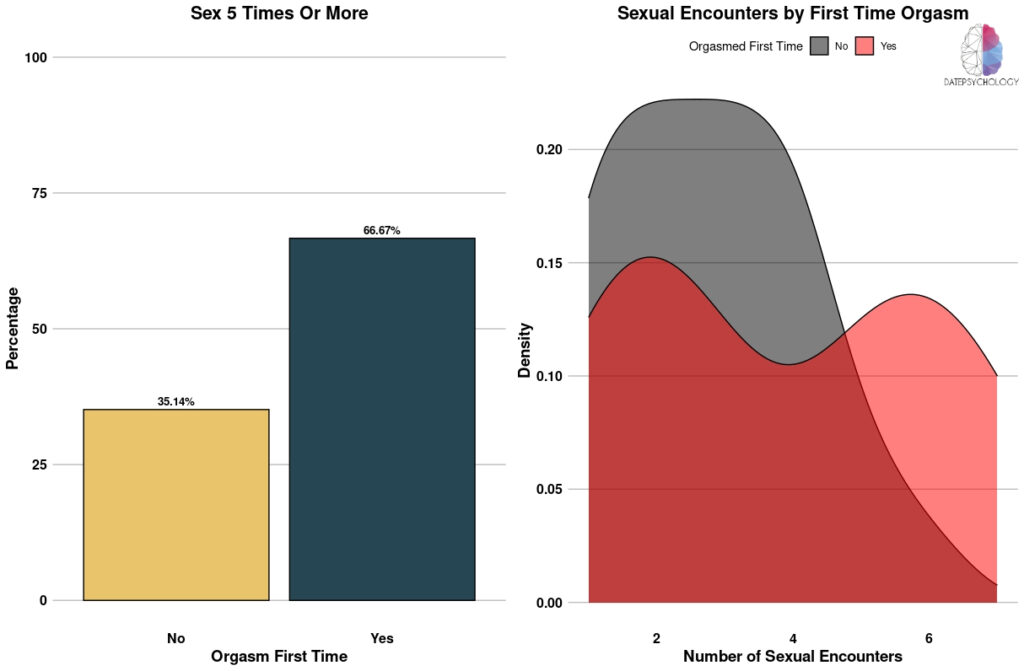
Reports of Orgasm Predict Subjective Sexual Satisfaction
Past research has found that having an orgasm is moderately to strongly associated with sexual satisfaction, relationship satisfaction, and physical intimacy for women (Kontula & Miettinen, 2016; Leonhardt et al., 2018; Wetzel et al., 2022). We also replicate the associations between orgasms for women and sexual satisfaction with short-term sexual partners.
Women who experienced an orgasm during the first sexual encounter reported significantly higher sexual satisfaction than women who did not (t(46.688) = -6.32, p < .001, 95% CI[-2.94, -1.52]) and the difference was large in size (d = -1.45). Women who experienced an orgasm at any time with short-term sexual partners also reported significantly higher sexual satisfaction than women who did not (t(29.089) = -7.60, p < .001, 95% CI[-3.75, -2.16]) and this effect was also large in size (d = -2.33). Image 16 shows these results.
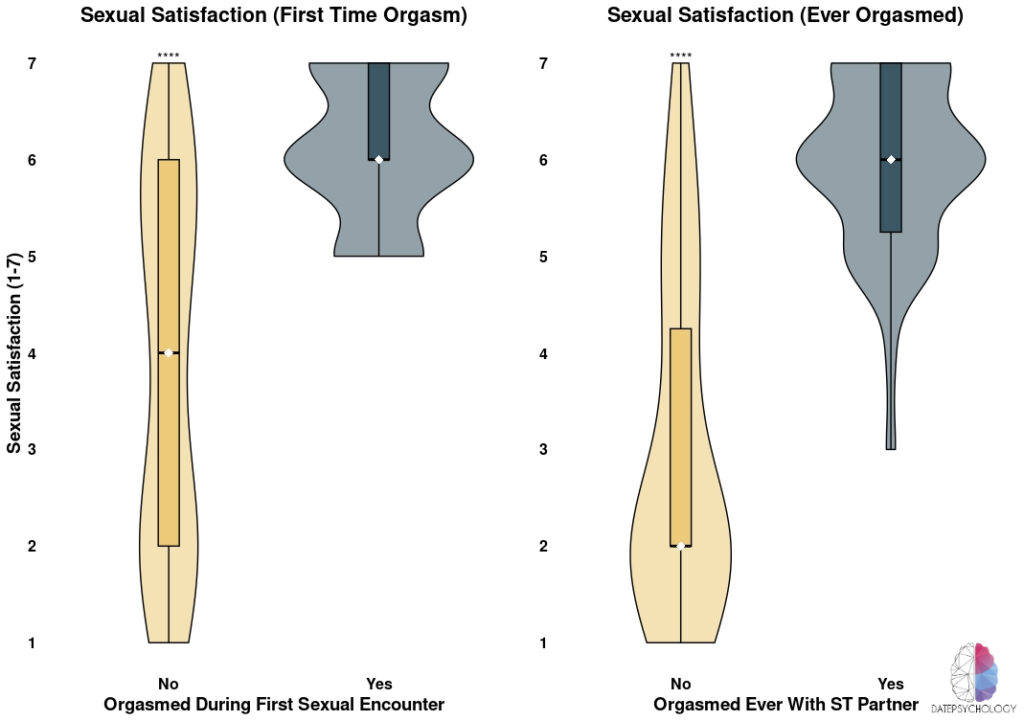
In past research, sex differences have been found in sexual regret following short-term sexual relationships: women tend to regret casual sex more than men (Galperin et al., 2013; Kennair et al., 2016, 2018). In one large sample, Uecker and Martinez (2017) found that 77% of women regretted having sex outside of a relationship while 53% of men did not. Not all research has found associations between orgasm and sexual regret (Jackson, 2022), but more generally across the research experiencing an orgasm and having high sexual satisfaction are associated with lower sexual regret (Fisher et al., 2012). Past research has also found that orgasm experience fully mediates the relationship between sex and negative emotional perceptions of casual sex (Piemonte et al., 2019).
Our results are consistent with past research showing a sex difference in sexual regret (t(106.65) = 2.881, p = 0.0048, 95% CI[0.27,1.46], d = 0.46). Women regretted the sex with their last short-term sexual partner more than men did.
Our results are also consistent with past research showing negative associations between orgasms and sexual regret. Women who experienced an orgasm during the first sexual encounter with their last short-term partner were significantly less likely to report regretting the sexual experience (t(60.25) = 5.03, p < .001, 95% CI[1.37, 3.18]) and the difference was large in size (d = 1.17). Women who reported ever having an orgasm with their last short-term sexual partner were also less likely to regret the sexual experience (t(32.70) = 5.02, p < .001, 95% CI[1.60, 3.78]) and this effect was also large in size (d = 1.45). Image 17 shows these results. Sexual regret was remarkably low for women who had experienced an orgasm; the median response was the lowest possible response.
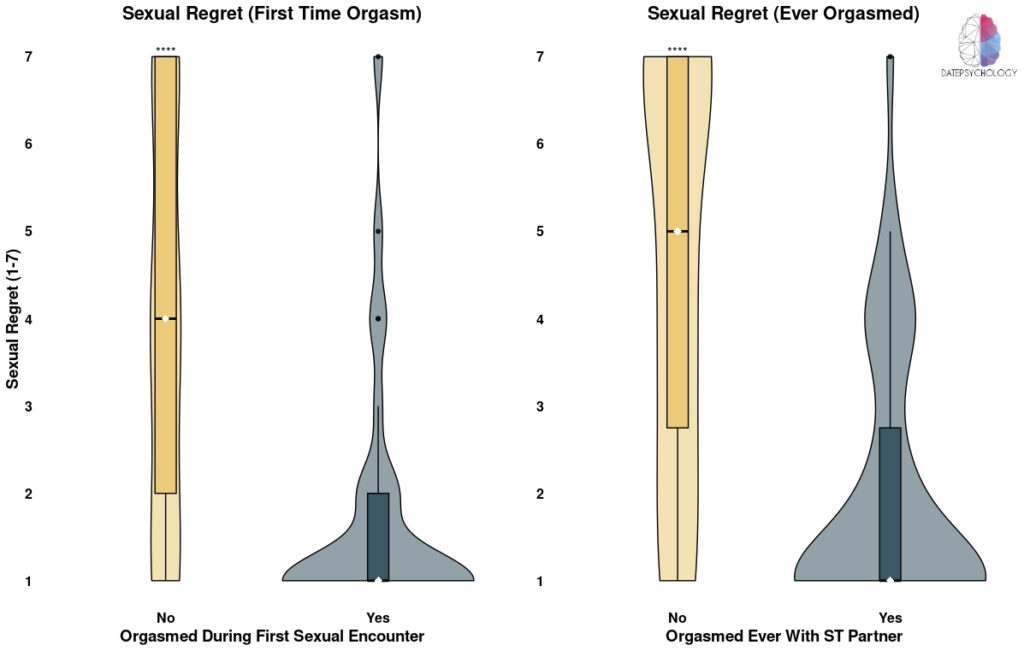
Sexual satisfaction was also significantly correlated with sexual regret; women who reported higher satisfaction with their sexual experiences with short-term partners reported lower sexual regret (r(68) = −0.54, p < .001, 95% CI[−0.69, −0.35]).
Piemonte et al. (2019) found that orgasm experience fully mediated the sex difference in emotional responses to casual sex. We performed a mediation analysis with Lavaan in R and we found the same effect in our dataset. The indirect effect of participant sex on sexual satisfaction mediated through having ever experienced an orgasm with the last short-term sexual partner was significant (β = −0.263, SE = 0.05, z = 5.229, p < .001) as was orgasm experience (β = −1.753, SE = 0.341, z = 5.134, p < .001). The direct effect of participant sex on sexual satisfaction was not significant (β = 0.405, SE = 0.271, z = 1.495, p = .135).
This was also true for sexual regret. The indirect effect of participant sex on sexual regret mediated through having ever experienced an orgasm was significant (β = −0.263, SE = 0.05, z = 5.229, p < .001) as was orgasm experience (β = −1.753, SE = 0.341, z = 5.134, p < .001). The direct effect of participant sex on sexual regret was not significant (β = 0.405, SE = 0.271, z = 1.495, p = .135).
In other words, sex differences in sexual regret and sexual satisfaction may be explained by women experiencing fewer or no orgasms compared with men. When orgasm is accounted for the sex difference is no longer significant.
Oral Sex and The Female Orgasm
In past research, oral sex has consistently and reliably been shown to produce female orgasms more frequently than penile-vaginal sex (Blair et al., 2017; Herbinck et al., 2018). Given this, we also sought to test if receiving oral sex during short-term sexual relationships was associated with orgasm in women.
A chi-square test for independence indicated a significant association between receiving oral sex and experiencing an orgasm for women (χ2(1, N = 221) = 5.09, p = .024). The percentage of female participants who did not receive oral sex and who nonetheless experienced an orgasm was 17.39%, compared to 82.61% of female participants who did receive oral sex and experienced an orgasm.
There was also a significant difference in sexual satisfaction between women who received oral sex and women who did not. Women who received oral sex reported higher sexual satisfaction (M = 5.27, SD = 1.13) compared to women who did not receive oral sex (M = 4.05, SD = 1.28) (t(25.58) = −2.16, p = .040, 95% CI[-2.38, -0.06] d = -0.67). Women who received oral sex also reported lower sexual regret (M = 2.51, SD = 1.30) than women who did not receive oral sex (M = 3.95, SD = 1.15) (t(26.26) = 2.19, p = .038, 95% CI[0.09, 2.79], d = 0.67).
Emotional Connections, Partner Traits, and Orgasm
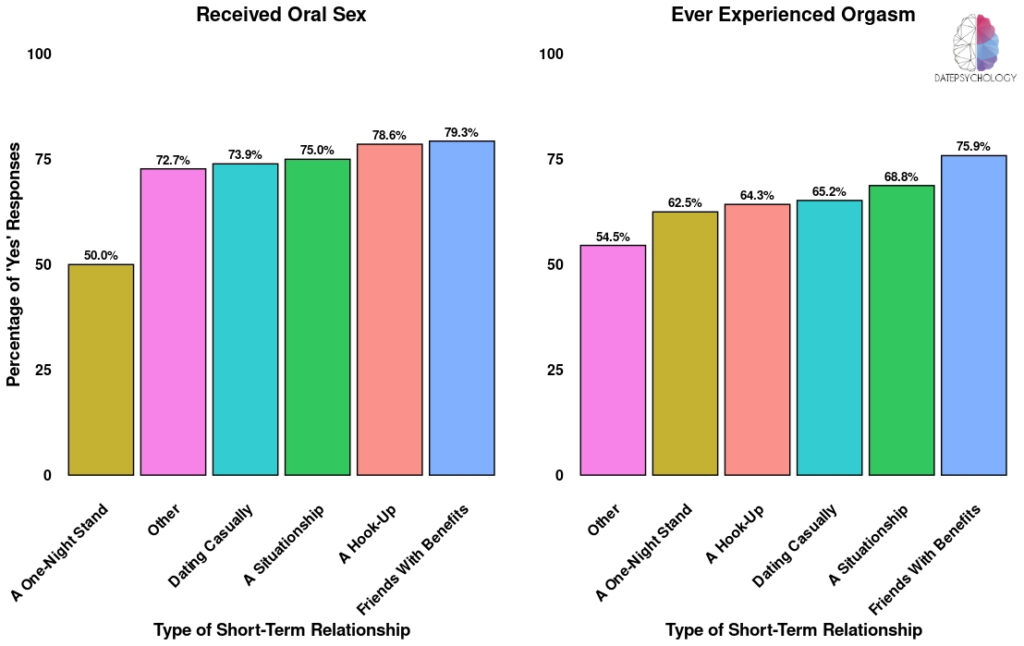
Given the relationship between oral sex, orgasm, and sexual satisfaction, we can also look at how oral sex and orgasm experiences are distributed between short-term relationship types (Image 18). Women received oral sex the least during one-night stands (although hook-ups are similarly high as longer short-term relationship patterns). Women also reported experiencing orgasm more during longer short-term relationship patterns (friends with benefits, situationships, and dating casually) than during shorter short-term relationship patterns (one-night stands and hook-ups).
Female participants who reported ever experiencing an orgasm were more likely to agree with the statement that they were in love with their short-term sexual partners (t(57.90) = -2.111, p = 0.039, 95% CI[-1.87, -0.05]). The relationship between orgasm and reporting an emotional attachment was not significant (t(45.26) = -1.637, p = 0.109, 95% CI[-2.07, 0.21]) nor was the relationship between orgasm and desiring a committed relationship with a short-term sexual partner (t(49.41) = -0.989, p = 0.328, 95% CI[-1.74, 0.59]).
We also found no significant relationships between sexual satisfaction and being in love (r(68) = 0.122, p = 0.315, 95% CI[-0.117, 0.347]), having an emotional connection r(68) = 0.145, p = 0.230, 95% CI[-0.093, 0.368]), nor desiring a committed relationship with a short-term sexual partner (r(68) = 0.063, p = 0.605, 95% CI[-0.175, 0.294]). Similarly, we found no significant relationships between sexual regret and being in love with a short-term partner (r(68) = 0.045, p = 0.714, 95% CI[-0.192, 0.277]), having an emotional attachment (r(68) = 0.045, p = 0.713, 95% CI[-0.192, 0.277]), nor desire for a committed relationship (r(68) = 0.123, p = 0.312, 95% CI[-0.116, 0.348]).
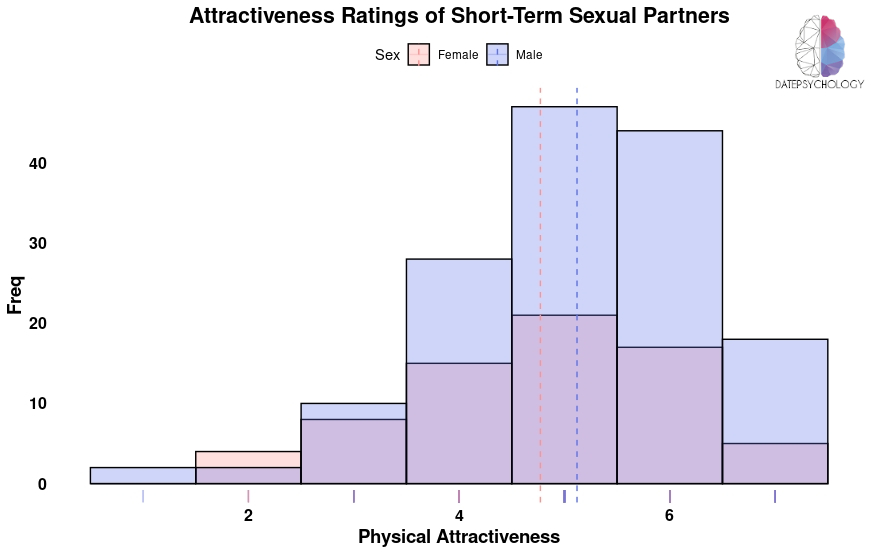
Height, Physical Attractiveness, and Orgasm
Participants also reported the physical attractiveness of their short-term sexual partners. Image 19 shows physical attractiveness ratings of short-term sexual partners by men and women. The mean difference between male and female participant ratings was not significant (t(129.36) = −1.88, p =0.063, 95% CI[-0.71, 0.02], d = -0.28).
For women, we found no significant difference in partner attractiveness between those who had an orgasm during the first sexual encounter and those who did not (t(40.11) = −1.199, p = 0.238, 95% CI[-1.109, 0.283], d = -0.32). We also found no significant difference in partner attractiveness between women who experienced an orgasm at any point and women who did not (t(67.97) = −0.285, p = 0.7767, 95% CI[-0.71, 0.53], d = -0.07). A significant, but small, correlation was found between self-reports of sexual satisfaction and partner attractiveness (r(68) = 0.24, p = 0.049, 95% CI[0.001, 0.446]) while the relationship between partner attractiveness and sexual regret was not significant (r(68) = −0.14, p = 0.256, 95% CI[-0.361, 0.101]).
For women, the relationship between short-term sexual partner height and sexual satisfaction was significant (r = 0.26, t(68) = 2.19, p = 0.032, 95% CI[0.02, 0.46]). The relationship between partner height and having ever experienced an orgasm with that partner was not significant (t(48.11) = -2.00, p = 0.051, 95% CI[-1.08, 0.00], d = -0.50), the relationship between partner height and having an orgasm the first time was not significant (t(67.96) = -0.77, p = 0.445, 95% CI[-0.73, 0.32], d = -0.18), and the relationship between partner height and sexual regret was not significant (r = -0.06, t(68) = -0.46, p = 0.644, 95% CI[-0.29, 0.18]).
We also conducted a logistic regression to determine if short-term sexual partner height predicted having an orgasm the first time and if it predicted having an orgasm at any point. Results were not significant for any height categories (all ps > .90). The null deviance in our model for first-time orgasms was 96.812, the residual deviance was 89.357, and the AIC was 101.36. For orgasms at any time, the null deviance was 90.1, residual deviance was 82.32, and the AIC was 94.32. The results suggest that short-term partner height does not predict the probability of experiencing an orgasm during the first sexual encounter nor in subsequent sexual encounters.
Prosocial Traits, Antisocial Traits, and Orgasm
Women who experienced an orgasm with a short-term sexual partner during their first sexual encounter had partners who were more prosocial than women who did not have a first-time orgasm (t(67.34) = −2.13, p =0.037, 95% CI[-6.61, -0.22], d = -0.50). Women who experienced an orgasm at any time also had more prosocial short-term partners than women who did not (t(41.97) = −2.50, p = 0.016, 95% CI[-7.89, -0.84], d = -0.66). There was a significant positive correlation between prosocial traits and sexual satisfaction (r = 0.34, t(68) = 3.01, p = 0.004, 95% CI[0.12, 0.53]) and a significant negative correlation between prosocial traits and sexual regret (r = −0.39, t(68) = −3.44, p =0.001, 95% CI[-0.57, -0.17]).
For antisocial traits, there was no significant difference for having ever experienced an orgasm (t(34.06) = 1.92, p = 0.063, 95% CI[-0.22, 7.91], d = 0.55). The difference was significant for having experienced an orgasm the first time, with the partners of women who experienced an orgasm the first time having lower antisocial trait scores (t(60.75) = 2.31, p = 0.024, 95% CI[0.51, 7.06], d = 0.54). Antisocial traits in short-term sexual partners were negatively correlated with sexual satisfaction (r = -0.27, t(68) = -2.34, p = 0.022, 95% CI[-0.48, -0.04]) and positively correlated with sexual regret (r = 0.40, t(68) = 3.62, p = 0.001, 95% CI[0.18, 0.58]).
Perceptions of prosocial and antisocial personality traits were better predictors of female orgasm, sexual satisfaction, and sexual regret than perceptions of male physical attractiveness and male height.
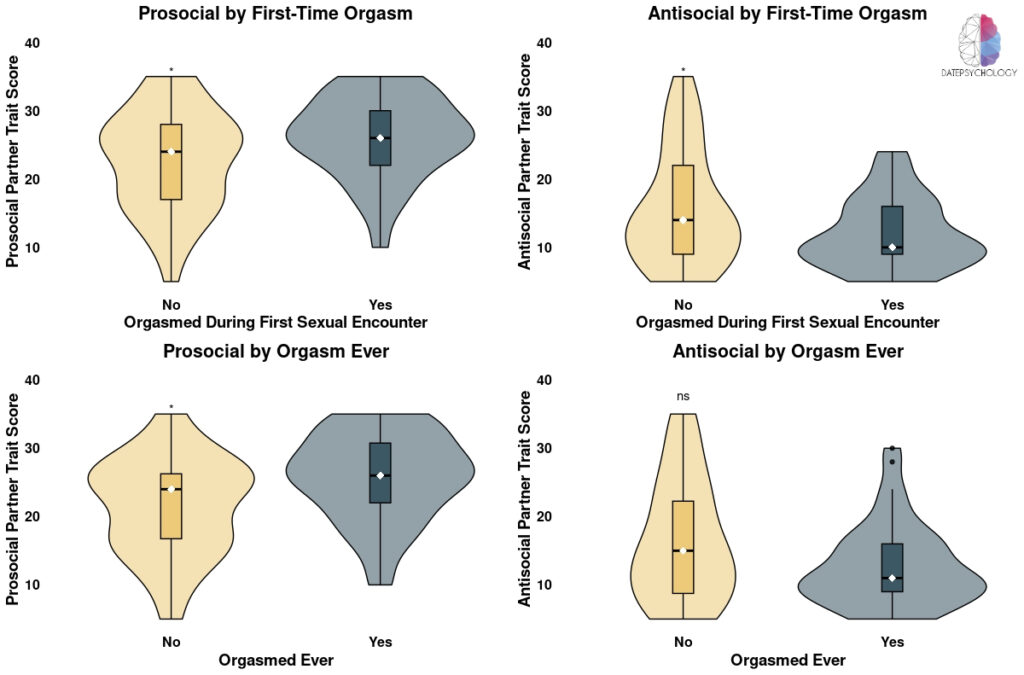
Hormonal Birth Control, Orgasm, and Partner Selection
Past research has found mixed results regarding effects of hormonal birth control on sexual behavior and partner choice. In our results, between women who reported using hormonal birth control and women who did not, we did not find a significant difference for ratings of short-term partner physical attractiveness (t(16.35) = −0.69, p =0.502, 95% CI[−1.24,0.63], d = -0.23), partner prosocial traits (t(27.30) = −1.27, p =0.216, 95% CI[−5.46,1.29], d = -0.30), partner antisocial traits (t(28.25) = 0.99, p =0.332, 95% CI[−1.80,5.14], d = 0.23), nor first time (χ2(1) = 0.20, p = 0.658) or ever (χ2(1) < 0.001, p =1.000) orgasm experiences. There was also no significant difference for sexual satisfaction (t(15.71) = 0.59, p =0.563, 95% CI[−1.04,1.85], d = 0.21) nor sexual regret (t(16.37) = −0.12, p=0.909, 95% CI[−1.71,1.53], d = -0.04) associated with hormonal birth control use.
Motives for Sex with Short-Term Partners & Associations With Orgasm
Women who reported that they were motivated to have sex with their last short-term partner because they were seeking a committed relationship with them were significantly less likely to have experienced an orgasm during the first time they had sex (t(65.61) = 2.09, p = 0.041, 95% CI[0.04,1.89], d = 0.49). Desire for a committed relationship did not significantly differ between women who experienced an orgasm ever and women who did not (t(41.35) = 0.97, p = 0.337, 95% CI[−0.56,1.58], d = 0.26). The relationship between desiring a committed relationship and sexual satisfaction was not significant (r = −0.09, t(68) = −0.78, p =0.440, 95% CI[−0.32,0.14]), however desiring a committed relationship was positively correlated with sexual regret (r = 0.36, t(68)= 3.19, p = 0.002, 95% CI[0.14,0.55]).
The motivation of being physically attracted to their last short-term sexual partner did not significantly differ between women who experienced an orgasm the first time and women who did not (t(67.11) = −1.55, p =0.126, 95% CI[−1.46,0.18], d = -0.37) nor did it differ between women who experienced an orgasm ever and women who did not (t(39.43) = −1.67, p =0.103, 95% CI[−1.71,0.16], d = -0.45). Being attracted to a short-term sexual partner was significantly correlated with sexual satisfaction (r = 0.38, t(68)=3.39, p = 0.001, 95% CI[0.16,0.56]), but not with sexual regret (r = −0.21, t(68) = −1.74, p = 0.087, 95% CI[−0.42,0.03]).
Women who experienced an orgasm during first-time sex with their last short-term sexual partner were more likely to report feeling horny as a motivation than women who did not (t(67.97) = −2.47, p = 0.016,95% CI[−1.63,−0.17], d = -0.59), although this difference was not significant for women who reported experiencing an orgasm at any point with their most recent short-term sexual partner (t(43.38) = −1.84, p = 0.072, 95% CI[−1.56,0.07], d = -0.48). We found a significant positive correlation between feeling horny as a motivation and sexual satisfaction (r = 0.30, t(68) = 2.55, p =0.013, 95% CI[0.07,0.50]) and a significant negative correlation between feeling horny as a motivation and sexual regret (r = −0.25, t(68) = −2.14, p = 0.036, 95% CI[−0.46,−0.02]).
Women who experienced an orgasm during their first sexual encounter with their most recent short-term sexual partner were less likely to report wanting to feel validated as a motive (t(66.85) = 2.26, p = 0.027, 95% CI[0.12,2.02], d = 0.53), but needing validation did not significantly differ between women who ever experienced an orgasm and women who did not (t(40.76) = 1.13, p = 0.27, 95% CI[−0.49,1.72], d = 0.30). Desiring validation as a motive was not significantly correlated with sexual satisfaction (r = −0.16, t(68) = −1.34, p =0.185, 95% CI[−0.38,0.08]), but was significantly and positively correlated with sexual regret (r = 0.28, t(68) = 2.40, p = 0.019, 95% CI[0.05,0.48]).
Women who experienced an orgasm during their first sexual encounter with their last short-term sexual partner were less likely to report feeling lonely as a motive for sex (t(67.90) = 2.46, p = 0.017, 95% CI[0.22,2.15], d = 0.58) and this was also true for women who reported experiencing an orgasm ever with their last short-term sexual partner (t(50.47) = 3.01, p = 0.004, 95% CI[0.49,2.46], d = 0.74). Sexual satisfaction was significantly and negatively correlated with feeling lonely as a motivation (r = −0.31, t(68) = −2.69, p =0.009, 95% CI[−0.51,−0.08]) while feeling lonely was significantly and positively correlated with sexual regret (r = 0.42, t(68) = 3.85, p <0.001, 95% CI[0.21,0.60]).
Result Summary
General Descriptives on Short-Term Relationship Patterns
- Approximately half of participants met short-term partners online.
- Short-term relationships were most often “intermediate” in nature or duration.
- FWBs, Situationships, and Casual Dating were more common than ONS and Hook-Ups.
- Participants, especially women, tended to have moderate-to-high knowledge about their short-term partners.
- Only ~20% of participants had sex with a short-term partner only once.
Emotions and Short-Term Relationship Intentions
- Women were more likely than men to be in love and have an emotional connection with short-term sexual partners.
- Men were more likely than women to believe short-term sexual partners were in love with them, had emotional connections with them, or desire committed relationships with them.
- Participants who were in love, had an emotional connection, or who desired a long-term relationship were more likely to report that their short-term partners felt similarly.
- Most participants endorsed “feeling horny” and “being physically attracted” as motivations for sex with a short-term partner.
- Very few participants endorsed “seeking a relationship” as a motivation for sex with a short-term partner.
- “Feeling lonely” and “seeking validation” had evenly mixed endorsement; these were sexual motivations for some participants but not others.
- Men were more likely than women to endorse “feeling horny” and “seeking validation.”
Replicating the Orgasm Gap
- Men were much more likely than women to experience an orgasm during the first sexual encounter and across all sexual encounters with short-term partners.
- Female orgasm during a first sexual encounter, as well as orgasm during any future sexual encounter, predicted going on to have more future sexual encounters.
- Female orgasm strongly predicted sexual satisfaction for women.
- Not having an orgasm strongly predicted sexual regret for women.
- Women experienced lower sexual satisfaction and higher sexual regret than men.
- This was fully mediated by orgasm experience. Significant sex differences in sexual satisfaction and sexual regret disappeared when orgasm was accounted for.
- Women who received oral sex were significantly more likely to have experienced orgasm at any time than women who did not.
- Hormonal birth control use did not predict orgasm experiences, sexual satisfaction, nor sexual regret for women.
Prosocial Traits, Antisocial Traits, and Orgasm
- Men and women were both much more likely to describe short-term sexual partners as having prosocial rather than antisocial traits. We found no sex difference.
- Men and women rated short-term partners as high in intelligence on average, with a small sex difference where women rated partners as more intelligent than men.
- Men and women rated short-term partners as high in physical attractiveness on average, with no sex difference in ratings.
- Prosocial partner traits predicted experiencing an orgasm during the first sexual encounter, an orgasm at any time, were positively correlated with sexual satisfaction, and negatively correlated with sexual regret.
- Antisocial partner traits were positively associated with sexual regret, negatively associated with sexual satisfaction, and predicted fewer first-time orgasms for women.
- Prosocial and antisocial ratings could not be explained by the halo effect; there were no correlations with physical attractiveness.
Motivational Associations with the Female Orgasm
- Women who reported experiencing orgasms were more likely to be in love with their short-term relationship partner.
- The physical attractiveness of a short-term sexual partner did not predict orgasm for women, but had a small association with sexual satisfaction.
- The height of a short-term partner did not predict orgasms nor sexual regrtet for women, but had a small association with sexual satisfaction.
- Women who were motivated to have sex with a short-term partner because they were seeking a relationship had fewer first-time orgasms and higher sexual regret.
- “Feeling horny” as a motivation predicted more orgasms, higher sexual satisfaction, and lower sexual regret.
- “Wanting validation” predicted fewer first-time orgasms and was associated with higher sexual regret.
- “Feeling lonely” as a motivation for sex was associated with fewer orgasms at any point, lower sexual satisfaction, and higher sexual regret.
Correlation Matrix of Selected Variables on Orgasm and Prosocial Behavior
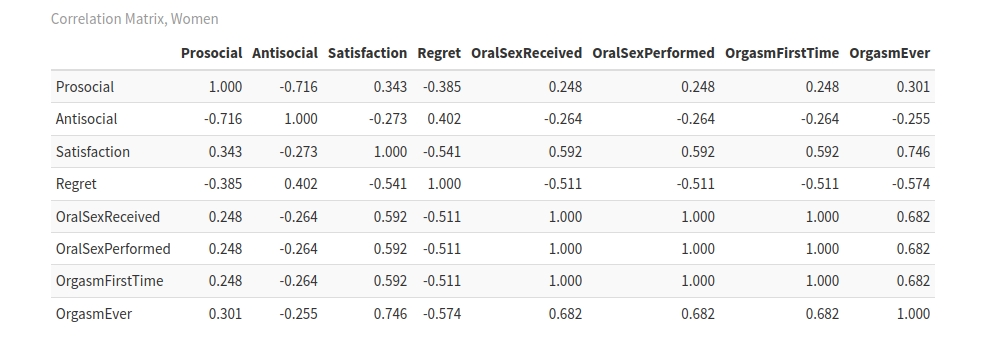
Discussion
Short-Term Mates Are Prosocial and Physically Attractive
Two trends that emerged from our descriptive data were that participants rated their short-term sexual partners to be physically attractive and behaviorally prosocial. We found no significant sex differences in ratings of short-term partners across these variables. Only 12% of participants rated their short-term partners as below average in physical attractiveness and only 19.5% rated short-term partners as average (a 4 on our 7-point linear response scale). To most participants, their most recent short-term sexual partner was above average in attractiveness.
Similarly, we found no sex differences for ratings of short-term partners in prosocial and antisocial traits. We found large differences in assessing short-term sexual partners as prosocial over antisocial (d = 1.62). Participants overwhelmingly described their last short-term sexual partner as empathetic, kind, respectful, and trustworthy, while only rarely describing them as manipulative, deceitful, selfish, or rude. For ratings of short-term partner intelligence we also found a similar trend, with recent short-term partners being assessed as above average intelligence in most cases. Only 14% of short-term partners were rated as below average in intelligence and only 17% were rated as average, with the remaining 69% rated as above average in intelligence.
The archetypes of the “bad boy” and the “nice guy” are a staple of our folk psychology. Especially in short-term relationship contexts, it is popular to assume high desirability for a “bad boy” and low desirability for a “nice guy.” What is meant by the terms “bad boy” and “nice guy,” however, is highly idiosyncratic and seems to differ from traits that are literally “bad” or “nice.” When examining actual antisocial and prosocial behavior, short-term sexual partners were much more likely to be described as “nice” by their partners. Conversely, short-term sexual partners tend to get rated quite low in antisocial traits associated with the Dark Triad.
These results are consistent with past research showing higher desirability for prosocial and attractive mates (Stewart et al., 2000; Regan et al., 2000; Ehlebracht, 2013; Farrelly & King, 2019).
To illustrate, we have taken data from Farrelly and King (2019) (Image 23). Farrelly and King paired photos that were high or low in physical attractiveness with vignettes that described high or low prosocial behavior. Photo/vignette pairings were then rated for desirability in short-term and long-term mating contexts. They found a significant and large main effect of prosocial behavior on desirability (η2 = .51). The interaction effect for relationship length was also significant but small (η2 = .12); prosocial behavior was more desirable in long-term relationship contexts. However, it would be a mistake to interpret this as prosocial being undesirable in short-term relationship contexts. The large main effect indicates that this is not so. Prosocial behavior is desirable across conditions. This is easily seen when visualizing the data:
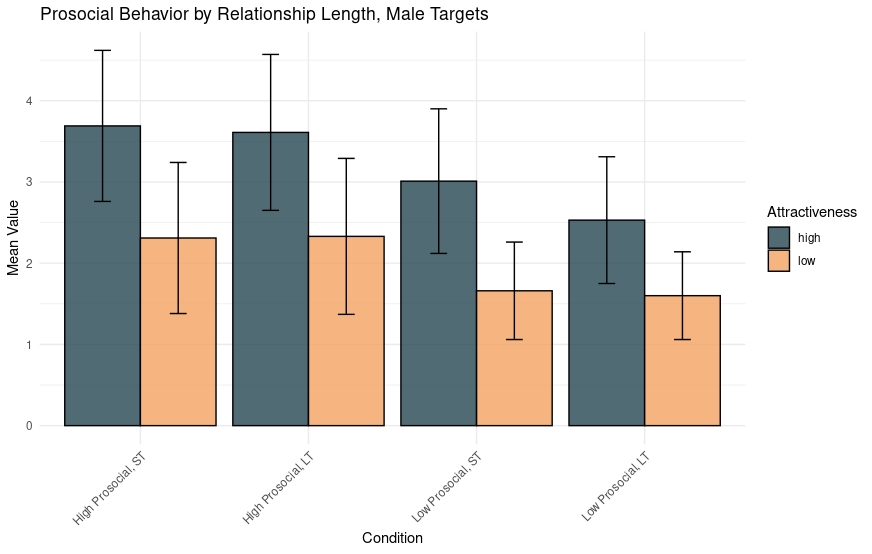
This is a common pattern throughout the research. The same traits, both physical and behavioral, are desired in short and long-term relationship contexts. Good traits may be weighted differently depending on the relationship context (e.g. physical attractiveness may be more important in short-term relationship contexts), but it is rarely the case that bad traits are valued for short or long-term relationships.
We recently conducted an experiment similar to the methodology used in Farrelly and King (2019) above (see: What Is An “Alpha Male”?) Our results were similar (Image 23). We found a large main effect for physical attractiveness (vignettes paired with photos of attractive men were rated as more “alpha” and more desirable for long and short-term relationships). We also found main effects and interactions with prosocial (V1) and antisocial (V2) behavior. Antisocial men were rated by women as less “alpha,” having lower status, and as less desirable in both short and long-term relationships than prosocial men. The penalty was especially strong for long-term relationships, but antisocial behavior was less desirable across all contexts.
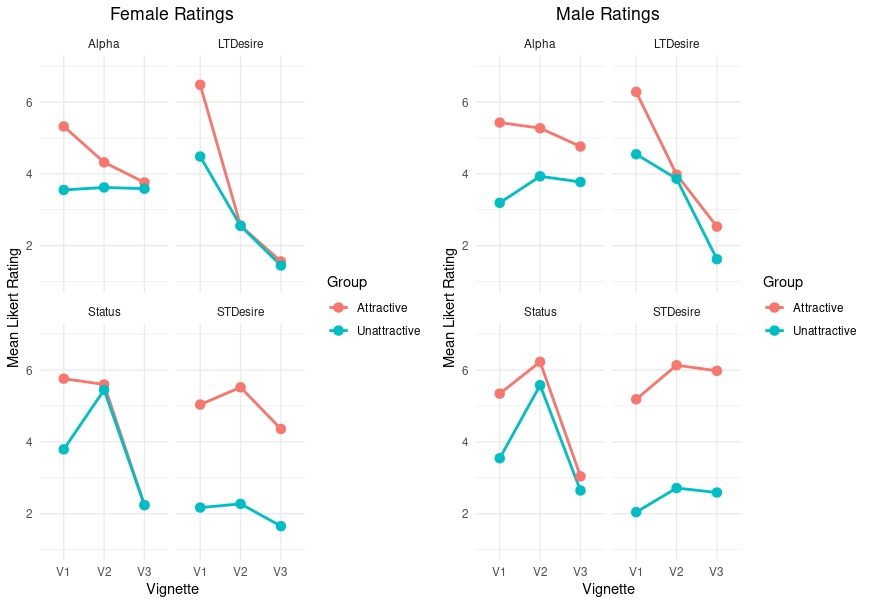
To illustrate this further, Table 3 shows data from a recent paper by Eastwick et al. (2024) comparing stated versus revealed mate selection preferences ranked in a large sample (N = 10,358) across 43 countries.
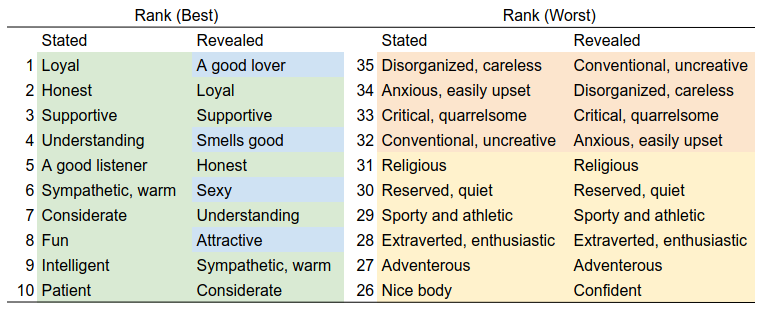
Positive and prosocial traits top the list both for stated and revealed preferences, although people underestimate the extent to which physical traits associated with attractiveness are important in actual mate choice. Meanwhile, the least desirable traits (35-32) are negative traits — both in stated and revealed preferences.
We have a sound theoretical basis to expect higher desirability of prosocial over antisocial partners in both short and long-term mating contexts. While there is evidence for a tradeoff between “good genes” as expressed through physical attractiveness and parental investment (Murphy et al., 2024), behavioral traits are also highly heritable. Selection for “good genes” may also include selection for prosocial behaviors that facilitate offspring survival. Sexual encounters also pose a risk of violence toward women, so selection for prosocial males may reduce the potential for risk and harm. Further, short-term relationships may not always be precisely that; short-term mating may function as an assessment for long-term mate choice.
Short-Term or Intermediate Relationships?
Many short-term relationships may also be understood as “intermediate” relationships, combining elements of short and long term mate selection preferences (LeFebvre & Rasner, 2023). Categorizing relationships as short or long term is also descriptive and may obscure the overlap that exists between the two (Eastwick et al., 2019). What seems to be casual sex to an outsider observer may turn out not to be so casual after all. Past research has found a majority of participants desired long-term relationships with their casual sex partner (Garcia & Reiber, 2008). In our sample we found a smaller percentage. While only 45% of women disagreed with the statement that they had an emotional attachment to short-term sexual partners, disagreement was higher for reports of being in love or desiring a committed relationship. Only 15% of male participants desired a long-term relationship with their casual sex partner and only 11% reported being in love with a casual sex partner. However, these were approximately twice as high for women. Further, when reporting partner intentions these percentages doubled. In other words, short-term mating seems to be more than just short-term for a substantial minority of our sample, especially for women.
Descriptive statistics describing relationships styles and reporting the number of sexual encounters also illustrate how short-term relationships may be understood as intermediate relationships on a short-to-long spectrum of relationship formation. Describing short-term relationships as “friends with benefits,” “situationships,” or “casually dating” was more common than “one-night stands” and “hook-ups.” Most participants had sex with their short-term partner more than once, with the largest category of participants having had sex with short-term partners ten times or more. Further, a large majority of participants knew basic information about their short-term sexual partners. Slightly more than half of participants met short-term sexual partners offline, potentially following some degree of acquaintance with one another beyond what might be formed on dating apps.
It is popular to portray or perceive short-term mating as casual, no-strings-attached sex with strangers, but this may be the exception rather than the rule.
The Orgasm Gap and Partner Selection
Consistent with past research, we found an orgasm gap in our sample: men experienced orgasms with short-term sexual partners more than women did. The orgasm gap existed both for first-time sexual encounters and across the entire duration of the short-term relationship. We also found a reduced orgasm gap associated with relationship duration for women, consistent with past research (Armstrong et al., 2012). The more sexual encounters female participants had with short-term partners, the more likely they were to have experienced an orgasm. Further, female participants who experienced an orgasm during the first sexual encounter were much more likely to go on to have higher numbers of sexual encounters with that same partner.
Orgasm experience was also a strong predictor of sexual satisfaction and sexual regret for women. Women who experienced an orgasm at any point reported much lower sexual regret and much higher sexual satisfaction. Further, and again consistent with past research (Piemonte et al., 2019), when orgasm experience was accounted for, sex differences in both sexual satisfaction and sexual regret disappeared.
We also found that receiving oral sex was strongly associated with having an orgasm for women. This, too, is not a novel finding (Blair et al., 2017; Herbinck et al., 2018). Only 17% of women who did not receive oral sex reported having an orgasm with their short-term sexual partner in our sample, compared to 82% of women who received oral sex.
Women who described their short-term relationships in more “intermediate” styles were more likely to report having experienced an orgasm. Conversely, women who described their relationships as “one-night stands” were the least likely to receive oral sex and among the least likely to have experienced an orgasm with their short-term partner. Women who reported experiencing an orgasm were also more likely to agree with the statement that they were in love with their short-term partner.
Prosocial short-term partner traits also predicted orgasm experiences for women. Women who experienced an orgasm the first time, as well as an orgasm at any time, had more prosocial short-term sexual partners. Prosocial partner traits were also positively correlated with sexual satisfaction and negatively correlated with sexual regret. Conversely, antisocial traits predicted fewer first-time orgasm experiences, lower sexual satisfaction, and higher sexual regret.
We found no significant relationships for the variables of male partner height and male partner physical attractiveness, with the exception of a small relationship between physical attractiveness and subjective sexual satisfaction. Attractiveness and height did not predict first-time orgasms nor having ever experienced an orgasm, nor did they predict sexual regret.
Support for Mate-Selection Hypotheses
These results are most consistent with a pair-bonding hypothesis regarding the adaptive function of the female orgasm. Orgasms increase alongside an increase in sexual pairings, or relationship duration. Orgasms during the first sexual encounter also predict who will continue to have sex, or maintain the short-term relationship. Further, prosocial behavioral traits that indicate high mate quality (both in short and long-term contexts as we have seen, but especially in long-term contexts) are positively associated with orgasm and sexual satisfaction, while being negatively associated with sexual regret. In other words, men who would make better long-term partners were also the most sexually satisfying short-term partners.
Table 6 from Puts et al. (2012) shows what results we might expect that are consistent with the sire choice hypothesis (facilitating the selection of high-quality genetics) and what results would be consistent with the pair-bond hypothesis (selection for long-term mates).
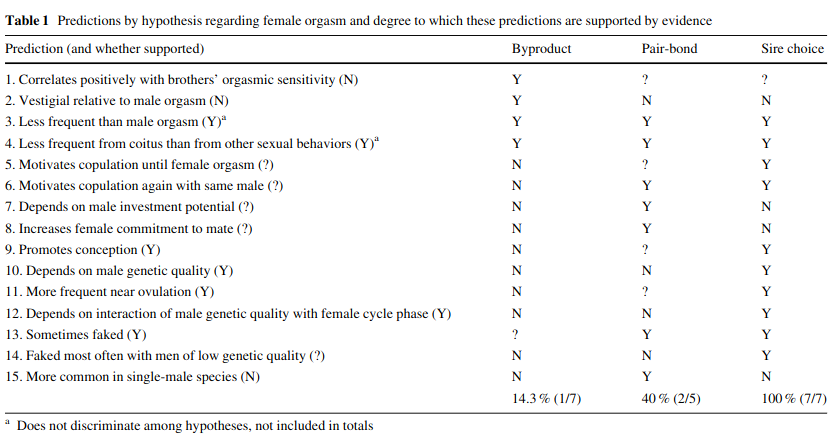
Sire-choice and pair-bond hypotheses are not mutually exclusive. In our results, we found that female orgasm was less frequent than the male orgasm, less frequent from coitus than oral sex, motivated future copulations (and with the same male), depended on male investment potential (assuming prosocial traits are indicative of this and antisocial traits are indicative of its opposite), and was inconsistently associated with female commitment (female participants in love reported having orgasms more, but we found no relationship with emotional attachments). Male genetic quality as indicated by height and physical attractiveness were not predictors of orgasm. However, a selection for prosocial behavior and intelligence may also be interpreted as a selection for “good genes.”
Conversely, our results are inconsistent with a byproduct or vestigial hypothesis. This is unsurprising, as byproduct hypotheses were early developments, and an abundance of past research has consistently shown adaptive functions of the female orgasm in mate choice (Puts et al., 2012).
Prosocial Partner Traits and Female Orgasm
In our results, short-term partners were assessed as prosocial overall and we found further associations between prosocial behavior in short-term partners, sexual satisfaction, and the female orgasm. Past research has found associations between female orgasm experiences, kindness, intelligence, and empathy (de Silva et al., 2023).
One hypothesis for the evolution of prosocial traits in human beings involves the variability of the female orgasm as a mechanism (Kennedy & Pavličev, 2018). Men usually orgasm through coitus while women often do not (and in our sample only 17% of women in our sample reported having an orgasm without oral sex). Yet, we also have strong evidence to support an adaptive function of the female orgasm in mate choice, mate retention, and potentially a biomechanical role in conception. Our early male ancestors who were both able to perceive what our female ancestors enjoyed, as well as who were willing or desirous of performing those sexual behaviors, may have been more likely to retain mates long enough to conceive. These cognitive skills would become theory of mind (Miller, 2007); they require cognitive and affective empathy, or the ability to accurately predict the thoughts and feelings of others.
As a result, more sexually attentive and astute males were selected over and beyond those who were not, shaping the evolution of theory of mind and high prosocial behavior in human beings.
The female orgasm is of course not the only, nor an exclusive, explanation for the development of human cognitive abilities nor prosocial traits. This may be just one mechanism among many strong, convergent pressures that produced a species relatively high in intelligence, empathy, and cooperation relative to other animals. However, if prosocial behavior was associated with male sexual behavior or interest in producing orgasms in female partners in our ancestral past this may be why we continue to see the association today, as well as why women are more likely to select and retain prosocial mates as short-term sexual partners.
Limitations and Strengths
As with most samples in psychology, we used a cross-sectional convenience sample so caution should be applied in assuming generalizability from our descriptive statistics. For example, as participants were selected from an online population we may expect more participants to have found short-term partners through online venues (dating apps or social media). A strength of our sample is that it represents a wider range of ages, is likely more diverse, and is more similar to the general population than most W.E.I.R.D. (Western, Educated, Industrialized, Rich, and Democratic) samples on political and feminist ideology.
The size of our female subsample was only sufficient to detect medium-sized effects. Many of our results ran in the expected direction when comparing means, but did not reach the threshold of statistical significance. If small-but-real associations exist between variables like physical attractiveness and orgasm experiences, these may be detected in future larger samples. Further, ceiling effects may obscure some associations in our sample. For example, our inability to find a relationship between physical attractiveness and orgasm may be because most short-term partners were rated as high in physical attractiveness. These associations may exist more broadly across the spectrum of physical attractiveness, but be minimized or obscured when assessing only attractive short-term partners.
Conclusion
This study represents one of few explorations of relationships between prosocial traits, orgasm, and short-term mating selection. Our results demonstrate a selection for prosocial sexual partners in short-term romantic contexts and provide support for the pair-bonding hypothesis of the female orgasm.
References
Algoe, S. B., Kurtz, L. E., & Grewen, K. (2017). Oxytocin and Social Bonds: The Role of Oxytocin in Perceptions of Romantic Partners’ Bonding Behavior. Psychological Science, 28(12), 1763-1772. https://doi.org/10.1177/0956797617716922
Armstrong, E. A., England, P., & Fogarty, A. C. (2012). Accounting for women’s orgasm and sexual enjoyment in college hookups and relationships. American Sociological Review, 77(3), 435-462.
Backstrom, L., Armstrong, E. A., & Puentes, J. (2011). Women’s Negotiation of Cunnilingus in College Hookups and Relationships. The Journal of Sex Research, 49(1), 1–12. https://doi.org/10.1080/00224499.2011.585523
Baker, R. R., & Bellis, M. A. (1993). Human sperm competition: Ejaculate manipulation by females and a function for the female orgasm. Animal behaviour, 46(5), 887-909.
Barclay, P. (2010). Altruism as a courtship display: Some effects of third‐party generosity on audience perceptions. British Journal of Psychology, 101(1), 123-135.
Birnie-Porter, C., & Hunt, M. (2015). Does relationship status matter for sexual satisfaction? The roles of intimacy and attachment avoidance in sexual satisfaction across five types of ongoing sexual relationships. The canadian journal of human sexuality, 24(2), 174-183.
Blumenthal, S. A., & Young, L. J. (2023). The neurobiology of love and pair bonding from human and animal perspectives. Biology, 12(6), 844.
Bell, S. (2018). What Happens in a Hook Up?: Young Women’s Behaviors, Emotions, and Pleasures (Doctoral dissertation).
Bhogal, M. S., Galbraith, N., & Manktelow, K. (2016). Sexual selection and the evolution of altruism: males are more altruistic and cooperative towards attractive females.
Bhogal, M. S., Farrelly, D., & Galbraith, N. (2019). The role of prosocial behaviors in mate choice: A critical review of the literature. Current Psychology, 38, 1062-1075.
Blair, K. L., Cappell, J., & Pukall, C. F. (2017). Not All Orgasms Were Created Equal: Differences in Frequency and Satisfaction of Orgasm Experiences by Sexual Activity in Same-Sex Versus Mixed-Sex Relationships. The Journal of Sex Research, 55(6), 719–733. https://doi.org/10.1080/00224499.2017.1303437
Brazil, K. J., Cloutier, D., De Las Llagas, N., McMahon, S. G., Benevides, V., Book, A. S., & Visser, B. A. (2023). The chameleons of dating: psychopathic traits are associated with mimicking prosocial personality traits in dating contexts. Evolutionary Psychological Science, 9(2), 260-269.
Brennan, P. L., Cowart, J. R., & Orbach, D. N. (2022). Evidence of a functional clitoris in dolphins. Current Biology, 32(1), R24-R26.
Breslin, P. A. (2013). An evolutionary perspective on food and human taste. Current Biology, 23(9), R409-R418.
Buss, D. M., & Shackelford, T. K. (1997). From vigilance to violence: mate retention tactics in married couples. Journal of personality and social psychology, 72(2), 346.
Buss, D. M. (2023). The sexual selection of human mating strategies: Mate preferences and competition tactics. The Oxford handbook of evolutionary psychology and romantic relationships, 15-41.
Carter, G. L., Campbell, A. C., & Muncer, S. (2014). The dark triad personality: Attractiveness to women. Personality and Individual Differences, 56, 57-61.
Cera, N., Vargas-Cáceres, S., Oliveira, C., Monteiro, J., Branco, D., Pignatelli, D., & Rebelo, S. (2021). How relevant is the systemic oxytocin concentration for human sexual behavior? A systematic review. Sexual Medicine, 9(4), 100370-100370.
Colson, M. H. (2010). Female orgasm: Myths, facts and controversies. Sexologies, 19(1), 8-14.
Craig, B. M., & Adams, A. K. (2009). Accuracy of body mass index categories based on self-reported height and weight among women in the United States. Maternal and child health journal, 13, 489-496.
da Silva, C. S. A., Mafra, A. L., de Moraes, Y. L., & Valentova, J. V. (2023). Female Orgasm as a Mate-Choice Cue-Testing Hypothesis about Its Evolutionary Function.
Eastwick, P. W., Finkel, E. J., & Simpson, J. A. (2019). The relationship trajectories framework: Elaboration and expansion. Psychological Inquiry, 30(1), 48-57.
Eastwick, P. W., Sparks, J., Finkel, E. J., Meza, E. M., Adamkovič, M., Adu, P., … & Coles, N. A. (2024). A worldwide test of the predictive validity of ideal partner preference-matching.
Ehlebracht, D. (2013). Doing good does you good: Prosocial behavior as a sexual and social signal (Doctoral dissertation, Universität zu Köln).
Ellsworth, R. M., & Bailey, D. H. (2013). Human female orgasm as evolved signal: A test of two hypotheses. Archives of Sexual Behavior, 42, 1545-1554.
Fallis, E. E., Rehman, U. S., Woody, E. Z., & Purdon, C. (2016). The longitudinal association of relationship satisfaction and sexual satisfaction in long-term relationships. Journal of Family Psychology, 30(7), 822.
Farrelly, D., & King, L. (2019). Mutual mate choice drives the desirability of altruism in relationships. Current Psychology, 38, 977-981.
Feingold, A. (1988). Matching for attractiveness in romantic partners and same-sex friends: A meta-analysis and theoretical critique. Psychological bulletin, 104(2), 226.
Fisher, M. L., Worth, K., Garcia, J. R., & Meredith, T. (2012). Feelings of regret following uncommitted sexual encounters in Canadian university students. Culture, Health & Sexuality, 14(1), 45-57.
Fleischman, D. S. (2016). An evolutionary behaviorist perspective on orgasm. Socioaffective neuroscience & psychology, 6(1), 32130
Frederick, D. A., Lever, J., Gillespie, B. J., & Garcia, J. R. (2017). What keeps passion alive? Sexual satisfaction is associated with sexual communication, mood setting, sexual variety, oral sex, orgasm, and sex frequency in a national US study. The Journal of Sex Research, 54(2), 186-201.
French, J. E., Altgelt, E. E., & Meltzer, A. L. (2019). The implications of sociosexuality for marital satisfaction and dissolution. Psychological science, 30(10), 1460-1472.
Frost, D. M., McClelland, S. I., & Dettmann, M. (2017). Sexual closeness discrepancies: What they are and why they matter for sexual well-being in romantic relationships. Archives of Sexual Behavior, 46, 2353-2364.
Gallup Jr, G. G., Ampel, B. C., Wedberg, N., & Pogosjan, A. (2014). Do orgasms give women feedback about mate choice?. Evolutionary Psychology, 12(5), 958-978.
Galperin, A., Haselton, M. G., Frederick, D. A., Poore, J., Von Hippel, W., Buss, D. M., & Gonzaga, G. C. (2013). Sexual regret: Evidence for evolved sex differences. Archives of sexual behavior, 42, 1145-1161.
Garcia, J. R., & Reiber, C. (2008). Hook-up behavior: A biopsychosocial perspective.Journal of Social, Evolutionary, and Cultural Psychology, 2(4), 192–208. https://doi.org/10.1037/h0099345
Gangestad, S. W., Dinh, T., Lesko, L., & Haselton, M. G. (2022). Understanding women’s estrus and extended sexuality: The dual sexuality framework.
Greeff, J. M., & Erasmus, J. (2015). Three hundred years of low non-paternity in a human population. Heredity, 115(5), 396-404.
Greitemeyer, T. (2020). Unattractive people are unaware of their (un) attractiveness. Scandinavian journal of psychology, 61(4), 471-483.
Herbenick D, Fu TJ, Arter J, Sanders SA, Dodge B. Women’s Experiences With Genital Touching, Sexual Pleasure, and Orgasm: Results From a U.S. Probability Sample of Women Ages 18 to 94. J Sex Marital Ther. 2018 Feb 17;44(2):201-212. doi: 10.1080/0092623X.2017.1346530. Epub 2017 Aug 9. PMID: 28678639.
Hensel, D. J., & O’Sulliban, L. F. (2022). What makes them last? Predicting time to relationship dissolution in adolescent women’s intimate relationships with male partners. Journal of Social and Personal Relationships, 39(2), 393-412.
Horwitz, T., & Keller, M. (2022). A comprehensive meta-analysis of human assortative mating in 22 complex traits.
Hunt, L. L., Eastwick, P. W., & Finkel, E. J. (2015). Leveling the playing field: Longer acquaintance predicts reduced assortative mating on attractiveness. Psychological Science, 26(7), 1046-1053.
Insel, T. R., & Hulihan, T. J. (1995). A gender-specific mechanism for pair bonding: Oxytocin and partner preference formation in monogamous voles. Behavioral Neuroscience, 109(4), 782–789. doi:10.1037/0735-7044.109.4.782
Jackson, A. (2022). Female Orgasm and Women’s Sexual Regret in the Context of One-Time Sexual Encounters. Bowling Green State University.
Jonason, P. K., & Fisher, T. D. (2009). The power of prestige: Why young men report having more sex partners than young women. Sex Roles, 60, 151-159.
Jonason, P. K., Lyons, M., & Blanchard, A. (2015). Birds of a “bad” feather flock together: The Dark Triad and mate choice. Personality and Individual Differences, 78, 34-38.
Kandler, C., Bleidorn, W., & Riemann, R. (2012). Left or right? Sources of political orientation: the roles of genetic factors, cultural transmission, assortative mating, and personality. Journal of personality and social psychology, 102(3), 633.
Kennedy, J., & Pavličev, M. (2018). Female orgasm and the emergence of prosocial empathy: An evo‐devo perspective. Journal of Experimental Zoology Part B: Molecular and Developmental Evolution, 330(2), 66-75.
Komisaruk, B. R., Whipple, B., Crawford, A., Liu, W. C., Kalnin, A., & Mosier, K. (2004). Brain activation during vaginocervical selfstimulation and orgasm in women with complete spinal cord injury: fMRI evidence of mediation by the vagus nerves. Brain Research,
Kennair, L. E. O., Bendixen, M., & Buss, D. M. (2016). Sexual regret: Tests of competing explanations of sex differences. Evolutionary Psychology, 14(4), 1474704916682903.
Kennair, L. E. O., Wyckoff, J. P., Asao, K., Buss, D. M., & Bendixen, M. (2018). Why do women regret casual sex more than men do?. Personality and Individual Differences, 127, 61-67.
Kontula, O., & Miettinen, A. (2016). Determinants of female sexual orgasms. Socioaffective neuroscience & psychology, 6(1), 31624.
Larmuseau, M. H. D., Vanoverbeke, J., Van Geystelen, A., Defraene, G., Vanderheyden, N., Matthys, K., … & Decorte, R. (2013). Low historical rates of cuckoldry in a Western European human population traced by Y-chromosome and genealogical data. Proceedings of the Royal Society B: Biological Sciences, 280(1772), 20132400.
Larmuseau, M. H., Matthijs, K., & Wenseleers, T. (2016). Cuckolded fathers rare in human populations. Trends in ecology & evolution, 31(5), 327-329.
Lee, D. H., Shin, A., Kim, J., Yoo, K. Y., & Sung, J. (2011). Validity of self-reported height and weight in a Korean population. Journal of epidemiology, 21(1), 30-36.
LeFebvre, L. E., & Rasner, R. D. (2023). Affective self-regulation after relationship dissolution. The Oxford Handbook of Human Mating.
Lentz, A. M., & Zaikman, Y. (2021). The big “O”: Sociocultural influences on orgasm frequency and sexual satisfaction in women. Sexuality & Culture, 25(3), 1096-1123.
Leonhardt, N. D., Willoughby, B. J., Busby, D. M., Yorgason, J. B., & Holmes, E. K. (2018). The significance of the female orgasm: A nationally representative, dyadic study of newlyweds’ orgasm experience. The journal of sexual medicine, 15(8), 1140-1148.
Lewis, R., & Marston, C. (2016). Oral sex, young people, and gendered narratives of reciprocity. The Journal of Sex Research, 53(7), 776-787.
Li, N. P., & Kenrick, D. T. (2006). Sex similarities and differences in preferences for short-term mates: what, whether, and why. Journal of personality and social psychology, 90(3), 468.
Mahar, E. A., Mintz, L. B., & Akers, B. M. (2020). Orgasm equality: Scientific findings and societal implications. Current Sexual Health Reports, 12(1), 24-32.
Miller, G. (2001). The mating mind: How sexual choice shaped the evolution of human nature. Anchor.
Miller, G. (2007). Kindness, fidelity, and other sexually selected virtues.
Moscovice, L. R., Surbeck, M., Fruth, B., Hohmann, G., Jaeggi, A. V., & Deschner, T. (2019). The cooperative sex: sexual interactions among female bonobos are linked to increases in oxytocin, proximity and coalitions. Hormones and Behavior, 116, 104581.
Murphy, M., Phillips, C. A., & Blake, K. R. (2024). Why women cheat: testing evolutionary hypotheses for female infidelity in a multinational sample. Evolution and Human Behavior, 45(5), 106595.
Nebl, P. J., & Gordon, A. K. (2022). The effect of female orgasm frequency on female mate selection: A test of two hypotheses. Evolutionary Psychology, 20(1), 14747049221083536.
Palode, B., & Evans, K. O. (2022). Upsuck Hypothesis. In Encyclopedia of Animal Cognition and Behavior (pp. 7144-7146). Cham: Springer International Publishing.
Petersen, J. L., & Hyde, J. S. (2010). A meta-analytic review of research on gender differences in sexuality, 1993–2007. Psychological bulletin, 136(1), 21.
Piemonte, J. L., Conley, T. D., & Gusakova, S. (2019). Orgasm, gender, and responses to heterosexual casual sex. Personality and Individual Differences, 151, 109487.
Puts, D. A., Dawood, K., & Welling, L. L. (2012). Why women have orgasms: An evolutionary analysis. Archives of sexual behavior, 41, 1127-1143.
Rancour-Laferriere, D. (1983). Four adaptive aspects of the female orgasm. Journal of Social and Biological Structures, 6(4), 319-333.
Regan, P. C., Levin, L., Sprecher, S., Christopher, F. S., & Gate, R. (2000). Partner preferences: What characteristics do men and women desire in their short-term sexual and long-term romantic partners?. Journal of Psychology & Human Sexuality, 12(3), 1-21.
Salkicevic, S., Stanic, A. L., & Grabovac, M. T. (2014). Good mates retain us right: Investigating the relationship between mate retention strategies, mate value, and relationship satisfaction. Evolutionary Psychology, 12(5), 1038-1052.
Schacht, R., & Kramer, K. L. (2019). Are we monogamous? A review of the evolution of pair-bonding in humans and its contemporary variation cross-culturally. Frontiers in Ecology and Evolution, 7, 426706.
Scott-Phillips, T. C., Dickins, T. E., & West, S. A. (2011). Evolutionary theory and the ultimate–proximate distinction in the human behavioral sciences. Perspectives on Psychological Science, 6(1), 38-47.
Sherlock, J. M., Sidari, M. J., Harris, E. A., Barlow, F. K., & Zietsch, B. P. (2016). Testing the mate-choice hypothesis of the female orgasm: disentangling traits and behaviours. Socioaffective Neuroscience & Psychology, 6(1), 31562.
Sprecher, S. (2002). Sexual satisfaction in premarital relationships: Associations with satisfaction, love, commitment, and stability. Journal of sex research, 39(3), 190-196.
Sprecher, S., Cate, R. M., Harvey, J. H., & Wenzel, A. (2004). Sexual satisfaction and sexual expression as predictors of relationship satisfaction and stability. The handbook of sexuality in close relationships, 235, 256.
Spielmann, S. S., Maxwell, J. A., MacDonald, G., Peragine, D., & Impett, E. A. (2020). The predictive effects of fear of being single on physical attractiveness and less selective partner selection strategies. Journal of Social and Personal Relationships, 37(1), 100-123.
Stewart, S., Stinnett, H., & Rosenfeld, L. B. (2000). Sex differences in desired characteristics of short-term and long-term relationship partners. Journal of social and personal relationships, 17(6), 843-853.
Surbey, M. K., & Conohan, C. D. (2000). Willingness to engage in casual sex: The role of parental qualities and perceived risk of aggression. Human Nature, 11, 367-386.
Symons, D. (1979). The evolution of human sexuality.
Troisi, A., & Carosi, M. (1998). Female orgasm rate increases with male dominance in Japanese macaques. Animal Behaviour, 56(5), 1261-1266.
Uecker, J. E., & Martinez, B. C. (2017). When and Why Women Regret Sex in Hookups More Than Men Do: An Analysis of the Online College Social Life Survey. The Sociological Quarterly, 58(3), 470–494.
Vance, G., Zeigler-Hill, V., Meehan, M. M., Young, G., & Shackelford, T. K. (2023). Sexual communal strength partially mediates the associations between mate retention behaviors and relationship satisfaction. The Journal of Sex Research, 60(3), 399-408.
Wade, L. D., Kremer, E. C., & Brown, J. (2005). The incidental orgasm: The presence of clitoral knowledge and the absence of orgasm for women. Women & health, 42(1), 117-138.
Weaver, S. J., & Herold, E. S. (2000). Casual Sex and Women. Journal of Psychology & Human Sexuality, 12(3), 23–41. doi:10.1300/j056v12n03_02
Webster, G. D., Li, Z., Park, S. Y., Mahar, E. A., Wongsomboon, V., & Rodriguez, L. M. (2024). Dyadic secondary meta-analysis: Attractiveness in mixed-sex couples. Personality and Individual Differences, 228, 112730.
Wiederman, M. W. (2007). A Narrow (But Thorough) Examination of the Evolutionary Significance of Female Orgasm-A BOOK REVIEW OF: The Case of the Female Orgasm: Bias in the Science of Evolution by Elisabeth J. Lloyd Cambridge, MA: Harvard University Press, 2005, 320 pp. Cloth, $27.95. Journal of Sex Research, 44(1), 104-105.
Wetzel, G. M., Cultice, R. A., & Sanchez, D. T. (2022). Orgasm frequency predicts desire and expectation for orgasm: Assessing the orgasm gap within mixed-sex couples. Sex Roles, 86(7), 456-470.
Wongsomboon, V., Burleson, M. H., & Webster, G. D. (2020). Women’s orgasm and sexual satisfaction in committed sex and casual sex: Relationship between sociosexuality and sexual outcomes in different sexual contexts. The Journal of Sex Research, 57(3), 285-295.
Yeh, H. C., Lorenz, F. O., Wickrama, K. A. S., Conger, R. D., & Elder Jr, G. H. (2006). Relationships among sexual satisfaction, marital quality, and marital instability at midlife. Journal of family psychology, 20(2), 339.
Young, L. J., & Wang, Z. (2004). The neurobiology of pair bonding. Nature neuroscience, 7(10), 1048-1054.
Zuk, M. (2006). The case of the female orgasm. Perspectives in Biology and Medicine, 49(2), 294-298.
2 comments
Even though I like you and find myself aligned with you, we can’t get anywhere with confirmation bias, loaded/restrictive questions, and biased samples. First, you really need to stop surveying your own Twitter echo chamber. Having statistics involved does not make this science. This is Twitter science, aka pseudoscience.
Warm regards.
I would conjecture causation goes the other way around more often: high mate value men get laid a lot, are in a perennially good mood, and behave and come across as kinder. I’m sure every man has experienced a significant uptick in the odds he will give homeless beggars money after a night with a particularly beautiful conquest.
“Prosocial” is a loaded, ideological and more useless than informative label here. A gang member who sells firearms in the black market, but is very kind and giving and pleasant to his friends, gang,, and family, will be considered prosocial by people in that social field, even though his prosociality is narrow and he is rather antisocial with possibly dark triad behaviors at a broader context and towards tribe outsiders. I think anecdotally we can all agree that this hypothetical dangerous but sweet arms dealer would be considered extremely appealing to women.